Online Classes Vs. Traditional Classes Essay
Online vs. in-person classes essay – introduction, online and traditional classes differences, works cited.
The article compares and contrasts online classes and traditional classes. Among the advantages of online classes are flexibility and convenience, while in-person classes offer a more structured learning environment. The author highlights that online lessons can be more cost-effective, although they lack support provided by live interactions. Overall, the online vs. traditional classes essay is very relevant today, and the choice depends on the individual student’s needs and preferences.
Modern technology has infiltrated the education sector and as a result, many college students now prefer taking online classes, as opposed to attending the traditional regular classes. This is because online classes are convenient for such students, and more so for those who have to both work and attend classes.
As such, online learning gives them the flexibility that they needed. In addition, online learning also gives an opportunity to students and professionals who would not have otherwise gone back to school to get the necessary qualifications. However, students who have enrolled for online learning do not benefit from the one-on-one interaction with their peers and teachers. The essay shall endeavor to examine the differences between online classes and the traditional classes, with a preference for the later.
Online classes mainly take place through the internet. As such, online classes lack the regular student teacher interaction that is common with traditional learning. On the other hand, learning in traditional classes involves direct interaction between the student and the instructors (Donovan, Mader and Shinsky 286).
This is beneficial to both the leaner and the instructors because both can be bale to establish a bond. In addition, student attending the traditional classroom often have to adhere to strict guidelines that have been established by the learning institution. As such, students have to adhere to the established time schedules. On the other hand, students attending online classes can learn at their own time and pace.
One advantage of the traditional classes over online classes is that students who are not disciplined enough may not be able to sail through successfully because there is nobody to push them around. With traditional classes however, there are rules to put them in check. As such, students attending traditional classes are more likely to be committed to their education (Donovan et al 286).
Another advantage of the traditional classes is all the doubts that students might be having regarding a given course content can be cleared by the instructor on the spot, unlike online learning whereby such explanations might not be as coherent as the student would have wished.
With the traditional classes, students are rarely provided with the course materials by their instructors, and they are therefore expected to take their own notes. This is important because they are likely to preserve such note and use them later on in their studies. In contrast, online students are provided with course materials in the form of video or audio texts (Sorenson and Johnson 116).
They can also download such course materials online. Such learning materials can be deleted or lost easily compared with handwritten class notes, and this is a risk. Although the basic requirements for a student attending online classes are comparatively les in comparison to students attending traditional classes, nonetheless, it is important to note that online students are also expected to be internet savvy because all learning takes place online.
This would be a disadvantage for the regular student; only that internet savvy is not a requirement. Students undertaking online learning are likely to be withdrawn because they hardly interact one-on-one with their fellow online students or even their instructors. The only form of interaction is online. As such, it becomes hard for them to develop a special bond with other students and instructors. With traditional learning however, students have the freedom to interact freely and this helps to strengthen their existing bond.
Online learning is convenient and has less basic requirements compared with traditional learning. It also allows learners who would have ordinarily not gone back to school to access an education. However, online students do not benefit from a close interaction with their peers and instructors as do their regular counterparts. Also, regular students can engage their instructors more easily and relatively faster in case they want to have certain sections of the course explained, unlike online students.
Donovan, Judy, Mader, Cynthia and Shinsky, John. Constructive student feedback: Online vs. traditional course evaluations. Journal of Interactive Online Learning , 5.3(2006): 284-292.
Sorenson, Lynn, and Johnson, Trav. Online Student Ratings of Instructions . San Francisco: Jossey Bass, 2003. Print.
- Walmart Workplace Aspects Analysis
- Organizational Behavior and Workplace Conflicts
- The Value of In-Person Human Interaction
- Principles Application in E-Learning
- Cambourne’s Conditions of Learning
- Concept of Transformative Learning in Modern Education
- Podcasts as an Education Tool
- Wikis as an Educational Tool
- Chicago (A-D)
- Chicago (N-B)
IvyPanda. (2019, April 25). Online Classes Vs. Traditional Classes Essay. https://ivypanda.com/essays/online-classes-vs-traditional-classes-essay/
"Online Classes Vs. Traditional Classes Essay." IvyPanda , 25 Apr. 2019, ivypanda.com/essays/online-classes-vs-traditional-classes-essay/.
IvyPanda . (2019) 'Online Classes Vs. Traditional Classes Essay'. 25 April.
IvyPanda . 2019. "Online Classes Vs. Traditional Classes Essay." April 25, 2019. https://ivypanda.com/essays/online-classes-vs-traditional-classes-essay/.
1. IvyPanda . "Online Classes Vs. Traditional Classes Essay." April 25, 2019. https://ivypanda.com/essays/online-classes-vs-traditional-classes-essay/.
Bibliography
IvyPanda . "Online Classes Vs. Traditional Classes Essay." April 25, 2019. https://ivypanda.com/essays/online-classes-vs-traditional-classes-essay/.
Thank you for visiting nature.com. You are using a browser version with limited support for CSS. To obtain the best experience, we recommend you use a more up to date browser (or turn off compatibility mode in Internet Explorer). In the meantime, to ensure continued support, we are displaying the site without styles and JavaScript.
- View all journals
- Explore content
- About the journal
- Publish with us
- Sign up for alerts
- Published: 25 January 2021

Online education in the post-COVID era
- Barbara B. Lockee 1
Nature Electronics volume 4 , pages 5–6 ( 2021 ) Cite this article
213 Citations
337 Altmetric
Metrics details
- Science, technology and society
The coronavirus pandemic has forced students and educators across all levels of education to rapidly adapt to online learning. The impact of this — and the developments required to make it work — could permanently change how education is delivered.
The COVID-19 pandemic has forced the world to engage in the ubiquitous use of virtual learning. And while online and distance learning has been used before to maintain continuity in education, such as in the aftermath of earthquakes 1 , the scale of the current crisis is unprecedented. Speculation has now also begun about what the lasting effects of this will be and what education may look like in the post-COVID era. For some, an immediate retreat to the traditions of the physical classroom is required. But for others, the forced shift to online education is a moment of change and a time to reimagine how education could be delivered 2 .

Looking back
Online education has traditionally been viewed as an alternative pathway, one that is particularly well suited to adult learners seeking higher education opportunities. However, the emergence of the COVID-19 pandemic has required educators and students across all levels of education to adapt quickly to virtual courses. (The term ‘emergency remote teaching’ was coined in the early stages of the pandemic to describe the temporary nature of this transition 3 .) In some cases, instruction shifted online, then returned to the physical classroom, and then shifted back online due to further surges in the rate of infection. In other cases, instruction was offered using a combination of remote delivery and face-to-face: that is, students can attend online or in person (referred to as the HyFlex model 4 ). In either case, instructors just had to figure out how to make it work, considering the affordances and constraints of the specific learning environment to create learning experiences that were feasible and effective.
The use of varied delivery modes does, in fact, have a long history in education. Mechanical (and then later electronic) teaching machines have provided individualized learning programmes since the 1950s and the work of B. F. Skinner 5 , who proposed using technology to walk individual learners through carefully designed sequences of instruction with immediate feedback indicating the accuracy of their response. Skinner’s notions formed the first formalized representations of programmed learning, or ‘designed’ learning experiences. Then, in the 1960s, Fred Keller developed a personalized system of instruction 6 , in which students first read assigned course materials on their own, followed by one-on-one assessment sessions with a tutor, gaining permission to move ahead only after demonstrating mastery of the instructional material. Occasional class meetings were held to discuss concepts, answer questions and provide opportunities for social interaction. A personalized system of instruction was designed on the premise that initial engagement with content could be done independently, then discussed and applied in the social context of a classroom.
These predecessors to contemporary online education leveraged key principles of instructional design — the systematic process of applying psychological principles of human learning to the creation of effective instructional solutions — to consider which methods (and their corresponding learning environments) would effectively engage students to attain the targeted learning outcomes. In other words, they considered what choices about the planning and implementation of the learning experience can lead to student success. Such early educational innovations laid the groundwork for contemporary virtual learning, which itself incorporates a variety of instructional approaches and combinations of delivery modes.
Online learning and the pandemic
Fast forward to 2020, and various further educational innovations have occurred to make the universal adoption of remote learning a possibility. One key challenge is access. Here, extensive problems remain, including the lack of Internet connectivity in some locations, especially rural ones, and the competing needs among family members for the use of home technology. However, creative solutions have emerged to provide students and families with the facilities and resources needed to engage in and successfully complete coursework 7 . For example, school buses have been used to provide mobile hotspots, and class packets have been sent by mail and instructional presentations aired on local public broadcasting stations. The year 2020 has also seen increased availability and adoption of electronic resources and activities that can now be integrated into online learning experiences. Synchronous online conferencing systems, such as Zoom and Google Meet, have allowed experts from anywhere in the world to join online classrooms 8 and have allowed presentations to be recorded for individual learners to watch at a time most convenient for them. Furthermore, the importance of hands-on, experiential learning has led to innovations such as virtual field trips and virtual labs 9 . A capacity to serve learners of all ages has thus now been effectively established, and the next generation of online education can move from an enterprise that largely serves adult learners and higher education to one that increasingly serves younger learners, in primary and secondary education and from ages 5 to 18.
The COVID-19 pandemic is also likely to have a lasting effect on lesson design. The constraints of the pandemic provided an opportunity for educators to consider new strategies to teach targeted concepts. Though rethinking of instructional approaches was forced and hurried, the experience has served as a rare chance to reconsider strategies that best facilitate learning within the affordances and constraints of the online context. In particular, greater variance in teaching and learning activities will continue to question the importance of ‘seat time’ as the standard on which educational credits are based 10 — lengthy Zoom sessions are seldom instructionally necessary and are not aligned with the psychological principles of how humans learn. Interaction is important for learning but forced interactions among students for the sake of interaction is neither motivating nor beneficial.
While the blurring of the lines between traditional and distance education has been noted for several decades 11 , the pandemic has quickly advanced the erasure of these boundaries. Less single mode, more multi-mode (and thus more educator choices) is becoming the norm due to enhanced infrastructure and developed skill sets that allow people to move across different delivery systems 12 . The well-established best practices of hybrid or blended teaching and learning 13 have served as a guide for new combinations of instructional delivery that have developed in response to the shift to virtual learning. The use of multiple delivery modes is likely to remain, and will be a feature employed with learners of all ages 14 , 15 . Future iterations of online education will no longer be bound to the traditions of single teaching modes, as educators can support pedagogical approaches from a menu of instructional delivery options, a mix that has been supported by previous generations of online educators 16 .
Also significant are the changes to how learning outcomes are determined in online settings. Many educators have altered the ways in which student achievement is measured, eliminating assignments and changing assessment strategies altogether 17 . Such alterations include determining learning through strategies that leverage the online delivery mode, such as interactive discussions, student-led teaching and the use of games to increase motivation and attention. Specific changes that are likely to continue include flexible or extended deadlines for assignment completion 18 , more student choice regarding measures of learning, and more authentic experiences that involve the meaningful application of newly learned skills and knowledge 19 , for example, team-based projects that involve multiple creative and social media tools in support of collaborative problem solving.
In response to the COVID-19 pandemic, technological and administrative systems for implementing online learning, and the infrastructure that supports its access and delivery, had to adapt quickly. While access remains a significant issue for many, extensive resources have been allocated and processes developed to connect learners with course activities and materials, to facilitate communication between instructors and students, and to manage the administration of online learning. Paths for greater access and opportunities to online education have now been forged, and there is a clear route for the next generation of adopters of online education.
Before the pandemic, the primary purpose of distance and online education was providing access to instruction for those otherwise unable to participate in a traditional, place-based academic programme. As its purpose has shifted to supporting continuity of instruction, its audience, as well as the wider learning ecosystem, has changed. It will be interesting to see which aspects of emergency remote teaching remain in the next generation of education, when the threat of COVID-19 is no longer a factor. But online education will undoubtedly find new audiences. And the flexibility and learning possibilities that have emerged from necessity are likely to shift the expectations of students and educators, diminishing further the line between classroom-based instruction and virtual learning.
Mackey, J., Gilmore, F., Dabner, N., Breeze, D. & Buckley, P. J. Online Learn. Teach. 8 , 35–48 (2012).
Google Scholar
Sands, T. & Shushok, F. The COVID-19 higher education shove. Educause Review https://go.nature.com/3o2vHbX (16 October 2020).
Hodges, C., Moore, S., Lockee, B., Trust, T. & Bond, M. A. The difference between emergency remote teaching and online learning. Educause Review https://go.nature.com/38084Lh (27 March 2020).
Beatty, B. J. (ed.) Hybrid-Flexible Course Design Ch. 1.4 https://go.nature.com/3o6Sjb2 (EdTech Books, 2019).
Skinner, B. F. Science 128 , 969–977 (1958).
Article Google Scholar
Keller, F. S. J. Appl. Behav. Anal. 1 , 79–89 (1968).
Darling-Hammond, L. et al. Restarting and Reinventing School: Learning in the Time of COVID and Beyond (Learning Policy Institute, 2020).
Fulton, C. Information Learn. Sci . 121 , 579–585 (2020).
Pennisi, E. Science 369 , 239–240 (2020).
Silva, E. & White, T. Change The Magazine Higher Learn. 47 , 68–72 (2015).
McIsaac, M. S. & Gunawardena, C. N. in Handbook of Research for Educational Communications and Technology (ed. Jonassen, D. H.) Ch. 13 (Simon & Schuster Macmillan, 1996).
Irvine, V. The landscape of merging modalities. Educause Review https://go.nature.com/2MjiBc9 (26 October 2020).
Stein, J. & Graham, C. Essentials for Blended Learning Ch. 1 (Routledge, 2020).
Maloy, R. W., Trust, T. & Edwards, S. A. Variety is the spice of remote learning. Medium https://go.nature.com/34Y1NxI (24 August 2020).
Lockee, B. J. Appl. Instructional Des . https://go.nature.com/3b0ddoC (2020).
Dunlap, J. & Lowenthal, P. Open Praxis 10 , 79–89 (2018).
Johnson, N., Veletsianos, G. & Seaman, J. Online Learn. 24 , 6–21 (2020).
Vaughan, N. D., Cleveland-Innes, M. & Garrison, D. R. Assessment in Teaching in Blended Learning Environments: Creating and Sustaining Communities of Inquiry (Athabasca Univ. Press, 2013).
Conrad, D. & Openo, J. Assessment Strategies for Online Learning: Engagement and Authenticity (Athabasca Univ. Press, 2018).
Download references
Author information
Authors and affiliations.
School of Education, Virginia Tech, Blacksburg, VA, USA
Barbara B. Lockee
You can also search for this author in PubMed Google Scholar
Corresponding author
Correspondence to Barbara B. Lockee .
Ethics declarations
Competing interests.
The author declares no competing interests.
Rights and permissions
Reprints and permissions
About this article
Cite this article.
Lockee, B.B. Online education in the post-COVID era. Nat Electron 4 , 5–6 (2021). https://doi.org/10.1038/s41928-020-00534-0
Download citation
Published : 25 January 2021
Issue Date : January 2021
DOI : https://doi.org/10.1038/s41928-020-00534-0
Share this article
Anyone you share the following link with will be able to read this content:
Sorry, a shareable link is not currently available for this article.
Provided by the Springer Nature SharedIt content-sharing initiative
This article is cited by
A comparative study on the effectiveness of online and in-class team-based learning on student performance and perceptions in virtual simulation experiments.
BMC Medical Education (2024)
Leveraging privacy profiles to empower users in the digital society
- Davide Di Ruscio
- Paola Inverardi
- Phuong T. Nguyen
Automated Software Engineering (2024)
Growth mindset and social comparison effects in a peer virtual learning environment
- Pamela Sheffler
- Cecilia S. Cheung
Social Psychology of Education (2024)
Nursing students’ learning flow, self-efficacy and satisfaction in virtual clinical simulation and clinical case seminar
- Sunghee H. Tak
BMC Nursing (2023)
Online learning for WHO priority diseases with pandemic potential: evidence from existing courses and preparing for Disease X
- Heini Utunen
- Corentin Piroux
Archives of Public Health (2023)
Quick links
- Explore articles by subject
- Guide to authors
- Editorial policies
Sign up for the Nature Briefing newsletter — what matters in science, free to your inbox daily.
Physical Learning vs. Online Learning: Which One is Better?
When it comes to learning, there’s a big difference in how people best absorb the knowledge that’s presented to them. Precisely for this reason, online learning, or digital learning, or e-learning as it is also called, is superior to traditional physical learning.
In this blog post, we look at the most prominent advantages of digital learning and why you should choose digital learning over physical learning.
Digital learning is knoweledge where and when it suits you
Have you ever sat in a physical learning environment on a late Monday afternoon? If you have, you probably know how it gets harder and harder to absorb knowledge as time goes on. If you instead move your course online, you can wave tired course participants goodbye. Contrary to the physical learning environment, participants can better maintain concentration online and achieve the desired benefit.

One of the biggest advantages of digital learning is that new knowledge can be accessed when your course participants are ready. Another big advantage is that they can access learning where it best suits them. Do they, for example, learn best on their couch with a cup of coffee in hand? No problem. Are they most ready to absorb knowledge on a Wednesday evening after the children are put to bed? Check! All this and much more is possible with digital learning .
Digital learning is not lost
Do you or your company use physical learning for, for example, onboarding processes, upskilling, or knowledge sharing? If yes, there’s a good change your learning processes aren’t up-to-date anymore.
New knowledge constantly emerges and to stay current, responsible learning and development managers need to optimize their learning processes. But if you’re using physical learning, this is easier said than done. Additionally, you risk loosing all knowledge and learning paths if your learning and development employee leaves the company.
If you instead rely on digital learning courses for your internal and external knowledge sharing processes, you’re guaranteed easy replication of your learning – regardless of whether employees come or go. You also avoid having to spend unnecessary (and expensive) hours in a physical learning environment. And at the same time, you ensure consistent digital learning every time a new employee is onboarded or needs upskilling.
Include interactive digital learning
Now, you’re maybe thinking that digital learning is just about short videos. If that’s correct, we can assure you that digital learning is so much more. While physical learning typically includes traditional blackboard teaching combined with independent learning, the possibilities of digital learning are almost endless.

With digital learning, you choose the best way to convey your knowledge – be it through audio, video, writing, or a combination. In addition, interactive elements such as quiz questions, chat functions and the like can also be used to create an inspiring learning module that maintains users’ interest and optimizes learning.
Transport and geography aren’t obstacle s
Are you currently in the process of developing a new physical course? If you are, you need to consider where it should take place so as many people as possible will benefit from it. It’s one of the necessities of physical learning.
No matter how exciting your course is, it can, however, be difficult to entice people to transport themselves great distances to participate. Your number of possible participants will therefore always be limited by the geographic location of the course.
If you instead create a digital learning course, your participants don’t have to worry about commuting or accommodation in order to participate. Suddenly every one become potential course participants, and it’s possible for you to receive many more registrations.
Optimize your learning process with valuable data
If you’ve ever created a course or learning path before, along the way you’ve probably realized what works and what doesn’t work.
But what if you could systemize these insights and use them to optimize the learning experience for your course participants? And what if this would make your participants want to come back time after time? That’s possible with digital learning.

One of the biggest advantages of digital learning vs. physical learning is the opportunity to quickly, easily, and automatically collect valuable data that you can use to optimize your course. With digital learning, you can, for example, get data on which of your courses are the most popular. But you can also collect data on time consumption, logins, and the user’s trial history.
All this data you can use to optimize your business and stay one step ahead of your competitors.
How do you get started with digital learning?
Are you ready to try digital learning?
We understand. When you use digital learning, you get all the benefits that we have mentioned above – and many more. And it’s easy to get started. We’ve even created a guide on how to get started with your own online academy .
Do you want to make your learning digital for the joy and benefit of your customers? Then book a free demo with us below.
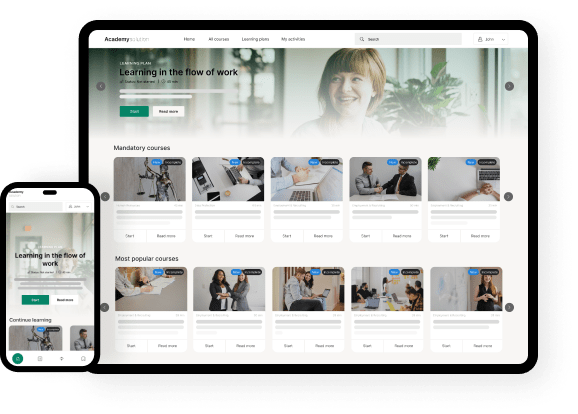
Ready to get your own digital learning platform?
Secure your free demo today, wait, we have more blog posts, gamification in online learning: how to engage your course participants, how to go from your first online course to a full-fledged online academy, 5 steps to creating successful online learning, what is an lms and when can you use it, functional impairment and e-learning: a social responsibility .

A digital platform for creating, distributing, and obtaining knowledge.
CVR: 38247662
- Success stories
- Become a partner
Terms | Privacy | © 2022 Cursum. All rights reserved.
Privacy Policy
This Privacy Policy aims to ensure that Cursum A/S, Rosenørns Alle 1, 1970 Frederiksberg C, CVR Number: 38247662 (hereafter referred to as “Cursum”) protects customers and their employees’ personal data in accordance with the rules for processing personal data that entered into force on May 25, 2018, as well as the current data protection laws applicable at any time. This policy describes responsibilities, data types and belongings as well as procedures for processing personal data, as outlined by the applicable EU Personal Data Regulation.
In Cursum, a data controller has been appointed to ensures that our personal data policy and implemented procedures are adhered to at all times, just as all Cursum employees are introduced to and taught in Cursum’s data policy and handling of personal data.
By using our services, you agree to Cursum handling your, and possibly, your employees’, personal information in accordance with this data policy.
Any future changes in our data policy will be made available through our website ( www.cursum.com ) and/or by direct distribution. The data policy was last amended 21 April 2018.
Information we collect about you
Cursum is a 100% digital organization and all person-related data is stored digitally. Therefore, there is no physical archive or any physical material containing personal data.
For the purpose of administration of learning and access to the Learning Center portal, Cursum stores and processes the following types of data for customers and their employees with access to lms.cursum.dk:
- Personal information: e-mail and name as well as possibly by the user’s own consent, education, gender, age, address and telephone number.
- Employment details: employer, division/department, title, workplace address, manager, phone number and employer’s email.
- Courses and performance: enrolled, commenced and completed courses and teaching activities with corresponding scores as well as obtained certificates and refreshments.
How we use this information
We use your data to improve your experience. Our service means that we keep your data inside the Cursum Learning Center unless you ask us or give us your permission to share it, for example, if you ask give us your permission to provide you with content and services through a partner’s platform.
We may use your personal information to:
- Register and maintain your account
- Remind you about activities and guided learning
- Allow you to use certain services or to inform you about changes to content and one or more available services
- Manage accounts and learning progress in accordance with requirements and wishes as part of an employment relationship
- Analyze the traffic on the website, including users’ use as well as demographic location to optimize our services
- Make inquiries if we suspect illegal activities or misuse
Who receives your personal information
We only use your data for internal quality analysis at Cursum and for ongoing documentation to our customers regarding the use of Cursum as part of an employment relationship.
In special cases, we may transfer your personal information to business partners and selected trusted third parties in order to register and maintain your user account and to help us deliver agreed goods and services to you.
Business partners all have confidentiality agreements and are not permitted to use personal data for other purposes. There will always be a relevant data processing agreement to ensure compliance with requirements and obligations in the EU Personal Data Regulation.
How we store your personal information
All data on Cursum’s learning platforms are hosted in Amazon or Azure’s European Data Centers in Ireland or the Netherlands, both of which comply with the requirements of the personal data regulation.
The website uses “cookies”, which allows Cursum to see which parts of the website the user’s browser has previously visited. A cookie is a small data file that is sent to your browser from a web server and stored on your computer’s hard drive.
Cookies are used to improve our website, to estimate your traffic and patterns; to keep information about your preferences so that the website can be customized to your individual interests; to make your search faster and to recognize your profile when you visit the website again.
You can set your browser to reject cookies. If you choose not to receive cookies, there may be certain subpages on the website that you cannot access. Our web server sends cookies to your computer every time you log on to our website unless you have set your browser to reject cookies.
For more information, see our cookie policy here.
How we protect your personal information
In accordance with the EU Personal Data Regulation of May 25, 2018, we have taken the necessary technical and organizational security measures against your personal data being accidentally or illegally destroyed, lost or impaired, or disclosed to unknown parties. We store personal information on our own or one of our business partners’ secure servers. The personal information you enter is encrypted before being forwarded to us. If you have received (or have chosen) a password that gives you access to specific subpages on the website, it is your responsibility that the password be kept secret. Therefore, do not share your password with others.
Access to your information and the right to be forgotten
You can always change your account information. You can find out what information we have registered about you. If you wish to receive a copy of this information, please write to us at the address given below. We may charge a small administration fee to cover the cost of sending the registered personal information to you. You may have erroneous information deleted or corrected You can request to have your information deleted:· If you are signed as a Private person you can contact the CLC team on the support form at our website, and request either a data overview or deletion.
- If you access through your employer you should contact your administrator of the Cursum Learning Center and ask questions about which data is stored, ask for a review of the current data stored or ask to be deleted.
In the event that Cursum is used as part of an employment relationship, the personal information may be subject to internal procedures and approvals via primary worker-to-employer inquiry, which is then required to submit an approved request to support Cursum in obligations towards the end user’s ability to execute their rights in accordance with the Personal Data Regulation.
Procedures for disposal
Upon termination of cooperation, Cursum stores all data described in the previous mentioned sections for 6-12 months. This is because customers often recalculate subscriptions within the first half to full year and data therefore has a commercial value for both Cursum and the customer. Upon termination of customer employees, Cursum stores all data described in previous sections for 12 months. This is because customer’s employees (end-users) are often relayed in another or similar position with the customer and therefore they will re-enter Cursum within the first 12 months after reported termination. Cursum keeps track of the certifications that the end user has obtained through a validity period. Data therefore has a commercial value for all parties. Data is systematically reviewed quarterly to check for termination and disposal according to the above. In addition, system-specific measures in the form of automatic erasure procedures have been implemented so that user data is not kept beyond the specified period.
Safety procedures against data breaches
Cursum has conducted and regularly performs systematic analysis and risk assessments. In order to avoid any risks, data exchange is on secure connections and access to personal, sensitive data in Cursum is limited to those employees where processing of data is relevant for the provision of services.
In the event of data breaches or suspicions hereof, Cursum’s data controller will contact the Data Protection Authority within 72 hours. The data controller, on this occasion, announces the following:
- Description of the data breach, how many people are affected and how much data is covered
- Contact information on a data manager in Cursum
- A description of possible consequences of data breakdown
- A description of actions Cursum plans to take to address the violation.
Additional information
If you have questions or comments about our data policy or how we use your personal information, please contact us at:
Cursum A/S, Rosenørns Allé 1, 1970 Frederiksberg C, Denmark
Email: [email protected]
Telephone: +45 70605818
Terms and Conditions
These terms and conditions outline the rules and regulations that govern your use of Cursum website. Your access to and use of any information on our website is conditioned on your acceptance and compliance with these terms. These terms apply to all visitors, users, and others who access our website. If you disagree with any part of our site’s terms, then you may refrain from using or accessing its content.
LICENSE TO USE OUR WEBSITE
Unless otherwise stated, Cursum or its licensors own the intellectual property rights for all materials on the website. All intellectual property rights are reserved. You may access this from our website for your personal use, but may be subject to restrictions set in these terms and conditions.
In addition, you must not:
- republish our blogs without our consent
- sell, rent, or sub-license material from the website
- reproduce and redistribute material from the Cursum website for commercial purposes
- edit or modify any material on the website
Website content like blogs and other multimedia is available for redistribution or republication only if you are given special permission. Otherwise, breaches of these terms of use may result to:
- Suspension of your access to the website
- Permanent prohibition of your access to the website
- Legal actions in response to copyright infringement
ACCEPTABLE USE
Using or copying information from Cursum’s website is permitted, provided that such materials will only be used for personal and non-commercial purposes. Our website should not also be in any way be used to cause damage or disruption to its accessibility and availability or in any acts that are unlawful, illegal, fraudulent, or harmful.
HYPERLINKING TO OUR CONTENT
We may consider and approve link requests if:
- a link is in the context of general resource information,
- it is not in any way deceptive or malicious (i.e., something that consists of any spyware, computer virus, Trojan horse, worm, keystroke logger, or rootkit)
- it does not falsely imply sponsorship, endorsement, or approval of the linking party and its products and/or services
Our blogs may contain links from other websites that are not owned or controlled by Cursum
We don’t have control over or responsibility for the content, privacy policies, or practices of any third-party websites or services.
You further acknowledge and agree that Cursum shall not be responsible, directly or indirectly, for any damage or loss caused or alleged to be caused by the use of such content, goods, or services available on or through such websites.
WEBSITE CHANGES
Cursum reserves the right to modify or replace these terms at any given time. If a revision is needed, we will try to provide at least a two-week notice before any new terms taking effect. What constitutes a material change will be determined at our sole discretion.
By continuing to access or use our website after those revisions become effective, you agree to be bound by the revised terms. If you do not agree to the new terms, please refrain from using our website.
The information, content, and services published on or through this website may include inaccuracies or errors. Cursum does not guarantee the accuracy of our materials. We disclaim all liability for such errors relating to the information and description of our technology and services displayed on our site. Your use of our website is at your sole risk. The materials on Cursum’s website are provided on an “as is” and “as available” basis. Cursum does not make any warranties, expressed or implied, including, but not limited to implied warranties of merchantability, fitness for a particular purpose, and non-infringement or course of performance.
In no event shall Cursum (nor its employees and directors) be liable for any direct or indirect damages arising out of, or in any way connected with, your access or use of this website.
You hereby agree to defend or indemnify Cursum against any claims, causes of action, demands, losses, damages, fines, liabilities, and penalties of any kind and nature, including but not limited to reasonable legal and accounting fees, brought by third parties as a result of your use of this site, breach of these terms and conditions, or your violation of any law or the rights of a third party.
LAW & JURISDICTION
Danish laws govern these terms and conditions, and you will irrevocably submit to the exclusive jurisdiction of the courts in any state or location within Denmark.
A Comparison of Student Learning Outcomes: Online Education vs. Traditional Classroom Instruction
Despite the prevalence of online learning today, it is often viewed as a less favorable option when compared to the traditional, in-person educational experience. Criticisms of online learning come from various sectors, like employer groups, college faculty, and the general public, and generally includes a lack of perceived quality as well as rigor. Additionally, some students report feelings of social isolation in online learning (Protopsaltis & Baum, 2019).
In my experience as an online student as well as an online educator, online learning has been just the opposite. I have been teaching in a fully online master’s degree program for the last three years and have found it to be a rich and rewarding experience for students and faculty alike. As an instructor, I have felt more connected to and engaged with my online students when compared to in-person students. I have also found that students are actively engaged with course content and demonstrate evidence of higher-order thinking through their work. Students report high levels of satisfaction with their experiences in online learning as well as the program overall as indicated in their Student Evaluations of Teaching (SET) at the end of every course. I believe that intelligent course design, in addition to my engagement in professional development related to teaching and learning online, has greatly influenced my experience.
In an article by Wiley Education Services, authors identified the top six challenges facing US institutions of higher education, and include:
- Declining student enrollment
- Financial difficulties
- Fewer high school graduates
- Decreased state funding
- Lower world rankings
- Declining international student enrollments
Of the strategies that institutions are exploring to remedy these issues, online learning is reported to be a key focus for many universities (“Top Challenges Facing US Higher Education”, n.d.).
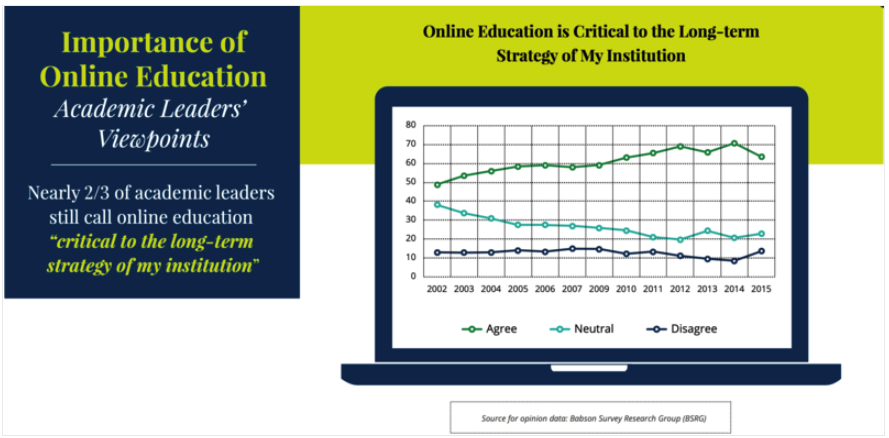
Babson Survey Research Group, 2016, [PDF file].
Some of the questions I would like to explore in further research include:
- What factors influence engagement and connection in distance education?
- Are the learning outcomes in online education any different than the outcomes achieved in a traditional classroom setting?
- How do course design and instructor training influence these factors?
- In what ways might educational technology tools enhance the overall experience for students and instructors alike?
In this literature review, I have chosen to focus on a comparison of student learning outcomes in online education versus the traditional classroom setting. My hope is that this research will unlock the answers to some of the additional questions posed above and provide additional direction for future research.
Online Learning Defined
According to Mayadas, Miller, and Sener (2015), online courses are defined by all course activity taking place online with no required in-person sessions or on-campus activity. It is important to note, however, that the Babson Survey Research Group, a prominent organization known for their surveys and research in online learning, defines online learning as a course in which 80-100% occurs online. While this distinction was made in an effort to provide consistency in surveys year over year, most institutions continue to define online learning as learning that occurs 100% online.
Blended or hybrid learning is defined by courses that mix face to face meetings, sessions, or activities with online work. The ratio of online to classroom activity is often determined by the label in which the course is given. For example, a blended classroom course would likely include more time spent in the classroom, with the remaining work occurring outside of the classroom with the assistance of technology. On the other hand, a blended online course would contain a greater percentage of work done online, with some required in-person sessions or meetings (Mayadas, Miller, & Sener, 2015).
A classroom course (also referred to as a traditional course) refers to course activity that is anchored to a regular meeting time.
Enrollment Trends in Online Education
There has been an upward trend in the number of postsecondary students enrolled in online courses in the U.S. since 2002. A report by the Babson Survey Research Group showed that in 2016, more than six million students were enrolled in at least one online course. This number accounted for 31.6% of all college students (Seaman, Allen, & Seaman, 2018). Approximately one in three students are enrolled in online courses with no in-person component. Of these students, 47% take classes in a fully online program. The remaining 53% take some, but not all courses online (Protopsaltis & Baum, 2019).

(Seaman et al., 2016, p. 11)
Perceptions of Online Education
In a 2016 report by the Babson Survey Research Group, surveys of faculty between 2002-2015 showed approval ratings regarding the value and legitimacy of online education ranged from 28-34 percent. While numbers have increased and decreased over the thirteen-year time frame, faculty approval was at 29 percent in 2015, just 1 percent higher than the approval ratings noted in 2002 – indicating that perceptions have remained relatively unchanged over the years (Allen, Seaman, Poulin, & Straut, 2016).
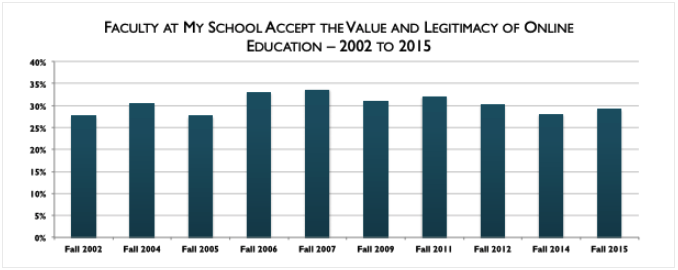
(Allen, I.E., Seaman, J., Poulin, R., Taylor Strout, T., 2016, p. 26)
In a separate survey of chief academic officers, perceptions of online learning appeared to align with that of faculty. In this survey, leaders were asked to rate their perceived quality of learning outcomes in online learning when compared to traditional in-person settings. While the percentage of leaders rating online learning as “inferior” or “somewhat inferior” to traditional face-to-face courses dropped from 43 percent to 23 percent between 2003 to 2012, the number rose again to 29 percent in 2015 (Allen, Seaman, Poulin, & Straut, 2016).
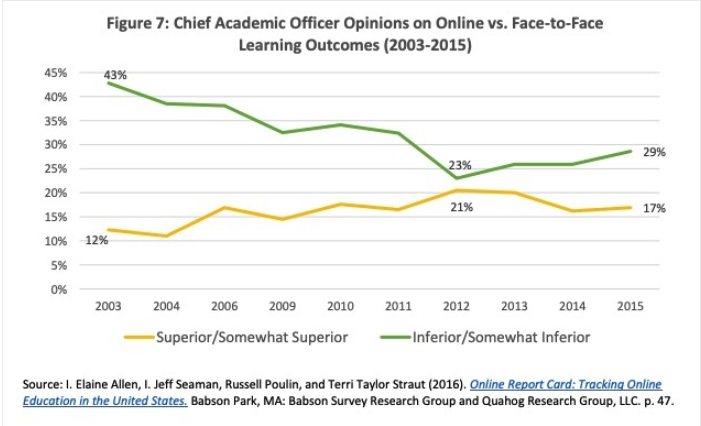
Faculty and academic leaders in higher education are not alone when it comes to perceptions of inferiority when compared to traditional classroom instruction. A 2013 Gallop poll assessing public perceptions showed that respondents rated online education as “worse” in five of the seven categories seen in the table below.
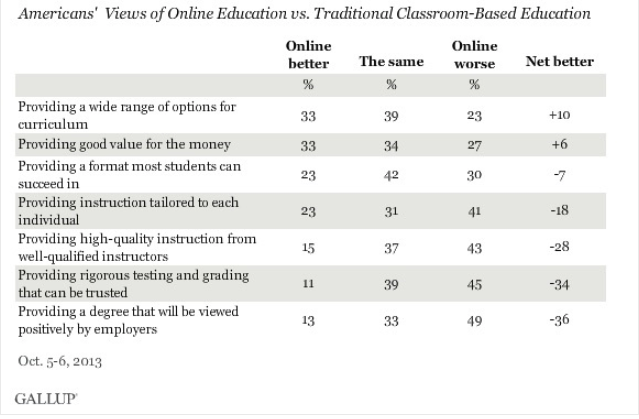
(Saad, L., Busteed, B., and Ogisi, M., 2013, October 15)
In general, Americans believed that online education provides both lower quality and less individualized instruction and less rigorous testing and grading when compared to the traditional classroom setting. In addition, respondents also thought that employers would perceive a degree from an online program less positively when compared to a degree obtained through traditional classroom instruction (Saad, Busteed, & Ogisi, 2013).
Student Perceptions of Online Learning
So what do students have to say about online learning? In Online College Students 2015: Comprehensive Data on Demands and Preferences, 1500 college students who were either enrolled or planning to enroll in a fully online undergraduate, graduate, or certificate program were surveyed. 78 percent of students believed the academic quality of their online learning experience to be better than or equal to their experiences with traditional classroom learning. Furthermore, 30 percent of online students polled said that they would likely not attend classes face to face if their program were not available online (Clienfelter & Aslanian, 2015). The following video describes some of the common reasons why students choose to attend college online.
How Online Learning Affects the Lives of Students ( Pearson North America, 2018, June 25)
In a 2015 study comparing student perceptions of online learning with face to face learning, researchers found that the majority of students surveyed expressed a preference for traditional face to face classes. A content analysis of the findings, however, brought attention to two key ideas: 1) student opinions of online learning may be based on “old typology of distance education” (Tichavsky, et al, 2015, p.6) as opposed to actual experience, and 2) a student’s inclination to choose one form over another is connected to issues of teaching presence and self-regulated learning (Tichavsky et al, 2015).
Student Learning Outcomes
Given the upward trend in student enrollment in online courses in postsecondary schools and the steady ratings of the low perceived value of online learning by stakeholder groups, it should be no surprise that there is a large body of literature comparing student learning outcomes in online classes to the traditional classroom environment.
While a majority of the studies reviewed found no significant difference in learning outcomes when comparing online to traditional courses (Cavanaugh & Jacquemin, 2015; Kemp & Grieve, 2014; Lyke & Frank 2012; Nichols, Shaffer, & Shockey, 2003; Stack, 2015; Summers, Waigandt, & Whittaker, 2005), there were a few outliers. In a 2019 report by Protopsaltis & Baum, authors confirmed that while learning is often found to be similar between the two mediums, students “with weak academic preparation and those from low-income and underrepresented backgrounds consistently underperform in fully-online environments” (Protopsaltis & Baum, 2019, n.p.). An important consideration, however, is that these findings are primarily based on students enrolled in online courses at the community college level – a demographic with a historically high rate of attrition compared to students attending four-year institutions (Ashby, Sadera, & McNary, 2011). Furthermore, students enrolled in online courses have been shown to have a 10 – 20 percent increase in attrition over their peers who are enrolled in traditional classroom instruction (Angelino, Williams, & Natvig, 2007). Therefore, attrition may be a key contributor to the lack of achievement seen in this subgroup of students enrolled in online education.
In contrast, there were a small number of studies that showed that online students tend to outperform those enrolled in traditional classroom instruction. One study, in particular, found a significant difference in test scores for students enrolled in an online, undergraduate business course. The confounding variable, in this case, was age. Researchers found a significant difference in performance in nontraditional age students over their traditional age counterparts. Authors concluded that older students may elect to take online classes for practical reasons related to outside work schedules, and this may, in turn, contribute to the learning that occurs overall (Slover & Mandernach, 2018).
In a meta-analysis and review of online learning spanning the years 1996 to 2008, authors from the US Department of Education found that students who took all or part of their classes online showed better learning outcomes than those students who took the same courses face-to-face. In these cases, it is important to note that there were many differences noted in the online and face-to-face versions, including the amount of time students spent engaged with course content. The authors concluded that the differences in learning outcomes may be attributed to learning design as opposed to the specific mode of delivery (Means, Toyoma, Murphy, Bakia, Jones, 2009).
Limitations and Opportunities
After examining the research comparing student learning outcomes in online education with the traditional classroom setting, there are many limitations that came to light, creating areas of opportunity for additional research. In many of the studies referenced, it is difficult to determine the pedagogical practices used in course design and delivery. Research shows the importance of student-student and student-teacher interaction in online learning, and the positive impact of these variables on student learning (Bernard, Borokhovski, Schmid, Tamim, & Abrami, 2014). Some researchers note that while many studies comparing online and traditional classroom learning exist, the methodologies and design issues make it challenging to explain the results conclusively (Mollenkopf, Vu, Crow, & Black, 2017). For example, some online courses may be structured in a variety of ways, i.e. self-paced, instructor-led and may be classified as synchronous or asynchronous (Moore, Dickson-Deane, Galyan, 2011)
Another gap in the literature is the failure to use a common language across studies to define the learning environment. This issue is explored extensively in a 2011 study by Moore, Dickson-Deane, and Galyan. Here, the authors examine the differences between e-learning, online learning, and distance learning in the literature, and how the terminology is often used interchangeably despite the variances in characteristics that define each. The authors also discuss the variability in the terms “course” versus “program”. This variability in the literature presents a challenge when attempting to compare one study of online learning to another (Moore, Dickson-Deane, & Galyan, 2011).
Finally, much of the literature in higher education focuses on undergraduate-level classes within the United States. Little research is available on outcomes in graduate-level classes as well as general information on student learning outcomes and perceptions of online learning outside of the U.S.
As we look to the future, there are additional questions to explore in the area of online learning. Overall, this research led to questions related to learning design when comparing the two modalities in higher education. Further research is needed to investigate the instructional strategies used to enhance student learning, especially in students with weaker academic preparation or from underrepresented backgrounds. Given the integral role that online learning is expected to play in the future of higher education in the United States, it may be even more critical to move beyond comparisons of online versus face to face. Instead, choosing to focus on sound pedagogical quality with consideration for the mode of delivery as a means for promoting positive learning outcomes.
Allen, I.E., Seaman, J., Poulin, R., & Straut, T. (2016). Online Report Card: Tracking Online Education in the United States [PDF file]. Babson Survey Research Group. http://onlinelearningsurvey.com/reports/onlinereportcard.pdf
Angelino, L. M., Williams, F. K., & Natvig, D. (2007). Strategies to engage online students and reduce attrition rates. The Journal of Educators Online , 4(2).
Ashby, J., Sadera, W.A., & McNary, S.W. (2011). Comparing student success between developmental math courses offered online, blended, and face-to-face. Journal of Interactive Online Learning , 10(3), 128-140.
Bernard, R.M., Borokhovski, E., Schmid, R.F., Tamim, R.M., & Abrami, P.C. (2014). A meta-analysis of blended learning and technology use in higher education: From the general to the applied. Journal of Computing in Higher Education , 26(1), 87-122.
Cavanaugh, J.K. & Jacquemin, S.J. (2015). A large sample comparison of grade based student learning outcomes in online vs. face-fo-face courses. Journal of Asynchronous Learning Network, 19(2).
Clinefelter, D. L., & Aslanian, C. B. (2015). Online college students 2015: Comprehensive data on demands and preferences. https://www.learninghouse.com/wp-content/uploads/2017/09/OnlineCollegeStudents2015.pdf
Golubovskaya, E.A., Tikhonova, E.V., & Mekeko, N.M. (2019). Measuring learning outcome and students’ satisfaction in ELT (e-learning against conventional learning). Paper presented the ACM International Conference Proceeding Series, 34-38. Doi: 10.1145/3337682.3337704
Kemp, N. & Grieve, R. (2014). Face-to-face or face-to-screen? Undergraduates’ opinions and test performance in classroom vs. online learning. Frontiers in Psychology , 5. Doi: 10.3389/fpsyg.2014.01278
Lyke, J., & Frank, M. (2012). Comparison of student learning outcomes in online and traditional classroom environments in a psychology course. (Cover story). Journal of Instructional Psychology , 39(3/4), 245-250.
Mayadas, F., Miller, G. & Senner, J. Definitions of E-Learning Courses and Programs Version 2.0. Online Learning Consortium. https://onlinelearningconsortium.org/updated-e-learning-definitions-2/
Means, B., Toyama, Y., Murphy, R., Bakia, M., & Jones, K. (2010). Evaluation of evidence-based practices in online learning: A meta-analysis and review of online learning studies. US Department of Education. https://www2.ed.gov/rschstat/eval/tech/evidence-based-practices/finalreport.pdf
Mollenkopf, D., Vu, P., Crow, S, & Black, C. (2017). Does online learning deliver? A comparison of student teacher outcomes from candidates in face to face and online program pathways. Online Journal of Distance Learning Administration. 20(1).
Moore, J.L., Dickson-Deane, C., & Galyan, K. (2011). E-Learning, online learning, and distance learning environments: Are they the same? The Internet and Higher Education . 14(2), 129-135.
Nichols, J., Shaffer, B., & Shockey, K. (2003). Changing the face of instruction: Is online or in-class more effective? College & Research Libraries , 64(5), 378–388. https://doi-org.proxy2.library.illinois.edu/10.5860/crl.64.5.378
Parsons-Pollard, N., Lacks, T.R., & Grant, P.H. (2008). A comparative assessment of student learning outcomes in large online and traditional campus based introduction to criminal justice courses. Criminal Justice Studies , 2, 225-239.
Pearson North America. (2018, June 25). How Online Learning Affects the Lives of Students . YouTube. https://www.youtube.com/watch?v=mPDMagf_oAE
Protopsaltis, S., & Baum, S. (2019). Does online education live up to its promise? A look at the evidence and implications for federal policy [PDF file]. http://mason.gmu.edu/~sprotops/OnlineEd.pdf
Saad, L., Busteed, B., & Ogisi, M. (October 15, 2013). In U.S., Online Education Rated Best for Value and Options. https://news.gallup.com/poll/165425/online-education-rated-best-value-options.aspx
Stack, S. (2015). Learning Outcomes in an Online vs Traditional Course. International Journal for the Scholarship of Teaching and Learning , 9(1).
Seaman, J.E., Allen, I.E., & Seaman, J. (2018). Grade Increase: Tracking Distance Education in the United States [PDF file]. Babson Survey Research Group. http://onlinelearningsurvey.com/reports/gradeincrease.pdf
Slover, E. & Mandernach, J. (2018). Beyond Online versus Face-to-Face Comparisons: The Interaction of Student Age and Mode of Instruction on Academic Achievement. Journal of Educators Online, 15(1) . https://files.eric.ed.gov/fulltext/EJ1168945.pdf
Summers, J., Waigandt, A., & Whittaker, T. (2005). A Comparison of Student Achievement and Satisfaction in an Online Versus a Traditional Face-to-Face Statistics Class. Innovative Higher Education , 29(3), 233–250. https://doi-org.proxy2.library.illinois.edu/10.1007/s10755-005-1938-x
Tichavsky, L.P., Hunt, A., Driscoll, A., & Jicha, K. (2015). “It’s just nice having a real teacher”: Student perceptions of online versus face-to-face instruction. International Journal for the Scholarship of Teaching and Learning. 9(2).
Wiley Education Services. (n.d.). Top challenges facing U.S. higher education. https://edservices.wiley.com/top-higher-education-challenges/
July 17, 2020
Online Learning
college , distance education , distance learning , face to face , higher education , online learning , postsecondary , traditional learning , university , virtual learning
Leave a Reply Cancel reply
Your email address will not be published. Required fields are marked *
Save my name, email, and website in this browser for the next time I comment.
© 2024 — Powered by WordPress
Theme by Anders Noren — Up ↑
Online? In Person? The Power of Letting Students Choose
Explore more.
- Classroom Management
- Course Design
- Digital Learning
I t’s been a full year since thousands of university faculty and millions of students made what’s likely the largest adjustment in instructional delivery in history, migrating mid-semester from physical classrooms to online ones. As the possible end of this great transition nears, higher education is exhaling a collective sigh of relief—but there is a new question facing most university faculty and administrators: now what?
Since last summer, university leaders have been busy determining when and how campuses can safely reopen. But as strategist and professor Vijay Govindarajan pointed out during an HBP webinar on COVID-19’s impact on the future of higher education last May , “while it’s important to attend to the challenge of the present, it’s equally important for universities and faculty to see the moment for what it is—a seismic shift within higher education.”
Those words ring even truer today. As most of us know by now, higher education is unlikely to fully return to pre–COVID-19 course delivery models. Millions of students have now experienced the intensive integration of technology into their courses, and this has likely reset their expectations for the future. Professor Govindarajan challenges us to use the lessons learned from the great transition to explore—more permanently—new models for instructional delivery.
Last fall, I did just that. I piloted a delivery approach, called the Choice Model, and implemented it in two of my principles-level business courses at Illinois College. The model, which allows students to choose, every day, whether they’ll attend class in person or online (via Zoom), was positively received by students. When surveyed, they said they preferred the Choice Model to all other delivery approaches combined (including fully in-person learning) by more than a two-to-one margin. Here, I will explain how I came up with and implemented this new model, how my students reacted, and how I plan to integrate it into my course design in the future.
What a Difference Autonomy Makes
While many colleges and universities have remained fully online since last March, many others—my institution among them—decided to open for face-to-face instruction for the Fall 2020 semester, with the first week and last two weeks taught remotely. As faculty, we were encouraged and supported to find ways to use technology to reduce student-to-student contact (per pandemic guidelines) and enhance learning. Empathizing with my students, I imagined that our announcement of in-person instruction was met with a combination of excitement about returning to the classroom and varying degrees of anxiety regarding the virus and what the fall might bring.
In times of stress, one of the factors that empowers individuals is the ability to exert a degree of control over their environment . I quickly determined that giving my students a choice in how they received their education would allow them to exert greater autonomy. Not to mention, developing students’ autonomy is a critical learning goal, and an explicit one in many UK universities .
This all got me thinking: if students were allowed to make choices in their education relative to the pandemic, perhaps their anxiety would decline and their performance would increase.
I developed the Choice Model in direct response to these factors. It’s similar to a hybrid model, but with one key distinction. The Choice Model lets each student choose—every day—whether they prefer to attend class in person or online.
Let’s dig more deeply into the model and how it came to be.
“One of the factors that empowers individuals is the ability to exert a degree of control over their environment.”
The Choice Model: Combining Flexibility and Engagement
During the summer of 2020, I began exploring students’ concerns about available course delivery options. Two common themes emerged:
Fear of the unknown. In conversations with former students, several said they would be hesitant to commit fulltime to a delivery format they weren’t familiar with (namely online learning). And they said risk was high: if the format wasn’t right for them, the only options would be to drop the course or to suffer through it for the entire semester.
Concerns about staying engaged and motivated. Several years ago, before my time at Illinois College, I conducted surveys with community college students about their experiences learning online. Their feedback was largely negative. Most had been in online courses that provided content, assignments, and a schedule of due dates, and students found it hard to be motivated or engaged.
Thus, an ideal course delivery system needed to provide students with a choice that enabled each student to move between delivery systems as their comfort level and environment changed. Giving students a daily choice could provide some feelings of control and reduced anxiety, while also allowing students new to digital course delivery to try it out. If it didn’t work for them, they could always return to attending in person.
For this model to work, however, I knew I needed a way to engage students both in the classroom and online. For me, the learning platform Echo360 became the critical link that elevated the Choice Model from other hybrid approaches. To keep in-class students and those participating on Zoom engaged in long class periods, I used Echo360 to ask students multiple choice questions every 10 minutes or so, checking in on students’ understanding of the content we had just covered in the session.
I graded responses on a mastery basis. Students received five points if they obtained a score of 70 percent or higher on the Echo360 questions asked on a given day, and zero points if they answered less than 70 percent correct. For students who paid attention and took notes, these questions were easy—for those who did not, they proved to be very difficult. As the semester progressed, the average scores on these questions increased (as did students’ exam scores, by one to two percent per exam). Similarly, student performance on an end-of-semester comprehensive final exam rose from 70.5 percent to 77.67 percent.
I also used the Echo360 platform to understand how my students would be attending class on any given day. The first question I always asked at the start of each session was, Are you attending today’s class:
A) In Person
B) Via Zoom
This allowed me to track not only what percentage of each student’s sessions were attended in-person versus on Zoom, but also the performance of in-person attendees versus Zoom attendees on the check-in questions asked throughout the session.
Positive Results, Positive Attitudes
What are the benefits of the choice model.
I’ve found the Choice Model, in which students can choose whether they attend class each day in person or online, benefits students, faculty, and administration in the following ways:
Student Benefits
Ease of attendance, ease of use. Requires only a smart phone and an internet connection to attend class. Echo360 is a free student download and takes five minutes to learn.
Fewer COVID-related anxieties. Students can decide whether to attend in person or online based on how secure they feel at the time of each class.
Faculty Benefits
Reduced risk of virus transmission. De-densifies the classroom, bringing fewer students into close contact with the professor and allowing for greater social distancing.
Relative ease of use. The only additional technology needed was a second webcam, a wireless lapel mic, and licenses for Zoom and Echo360.
Administration Benefits
Ability to maintain class sizes and avoid additional staffing. Due to the need to social distance in classrooms, a classroom that normally holds 35+ students might now only hold 15, necessitating additional classrooms and staffing. The Choice Model allows those students to voluntarily separate so that only one classroom and one educator is needed.
I also saw comprehensive final exam scores increase by seven points in a Choice Model class over another section taught fully in person a year earlier. Students credited the use of the check-in Echo360 questions during each class session as being helpful for keeping them engaged with the material during 70- and 100-minute classes.
Attendance also increased from 85 percent in Fall 2019 to 93 percent in Fall 2020, since the most common reasons for not being in class—not feeling well, being unable to get to campus, having to be out of town, etc.—were no longer barriers. An additional benefit of the Choice Model was the ease of teaching students who were placed in quarantine or isolation. In these instances, all I needed to do was to email the student to check on their health and well-being, and then to remind them to simply attend class using Zoom, if they were feeling up for it.
By the end of the fall semester, the Choice Model seemed to be a popular innovation with students. In a post-semester survey, I asked students to rate the model on a scale of 1 to 7 (with 7 being high), and the mean response was 6.7. When asked to rank the Choice Model among other course delivery alternatives—such as fully in person, fully on Zoom, and a 50/50 hybrid approach—30 out of 44 students ranked the Choice Model as their number-one preferred course delivery model, well ahead of fully in-person instruction.
Responding to Challenges
The model was not flawless, however. One challenge of the Choice Model was the passive nature of Zoom attendees. Echo360 was effective at engaging students with the course content, but getting students to engage with each other was another issue. Since these were principles-level classes, few of the students were familiar to me prior to the start of the course, which also made relationship building a slower process. In a post-COVID world, I intend to make greater effort to build those relationships when implementing this model.
A second challenge involved teaching quantitative material through the Choice Model. Students attending through Zoom seemed to struggle more with material that involved quantitative problem solving compared to their peers attending in person. Providing Zoom attendees with recordings of classes and additional video support was unsuccessful. A greater level of coaching on my part and increased diligence on the part of students was needed.
A third challenge was that, while giving students choices is generally positive and empowering, not every student choice is going to be a good choice. One of the unfortunate consequences of the Choice Model was that some students who needed the structure and peer-support of a classroom chose instead to attend through Zoom. The effect of not choosing wisely became apparent when grades were issued at midterm. While the number of poorly performing students was not significantly greater than usual, the extent of their poor performance was concerning, with most of the poor performers averaging below 50 percent.
Follow-up conversations with Zoom students who were performing poorly revealed that they had two other things in common—they attended class with their cameras off, and they were multitasking while attending (eating lunch, cleaning the room, working out, etc.). Most of the students with low performance said that they chose to attend via Zoom specifically for the convenience and so they could multitask. I had to explain to them that their strategy was not working. Many of those students chose to continue attending via Zoom, even after being told they would do better by being in the classroom. However, in most cases, students’ self-reported multitasking ended, their in-class quiz scores generally increased, and their performance improved to the point of passing.
“Giving students a daily choice could provide some feelings of control and reduced anxiety, while also allowing students new to digital course delivery to try it out.”
Imagining a Post-COVID Future That Includes the Choice Model
While there are some issues and limitations with the Choice Model that still need refinement, I am confident this model is applicable well beyond the current pandemic for the following reasons:
From a student perspective, the Choice Model adds value to the student experience by allowing students to choose the form their education will take each day. Even if a student chooses the same option every day, the fact that they have a choice at all still has value.
The model offers convenience and flexibility to students, especially for those who prefer in-person instruction but do not want to be locked into being on campus. For the type of student who often has work or personal conflicts, the Choice Model provides a Zoom option as a safety net. Conversely, a student who is unsure how well they will learn in an online environment also has a safety net, knowing there is an option for in-person instruction if needed.
For colleges and universities, the Choice Model has significant potential as a cost-effective alternative to online instruction. This is particularly true for online courses that are unlikely to enroll large numbers of students yet need to be offered. It is inefficient to offer an online course with only 12 students while also offering an on-campus section of the same course with 20 students. This requires twice the staffing resources compared to one section of 32 students taught through the Choice Model.
In March of 2020, higher education faced one of the greatest crises it’s ever encountered, certainly in my lifetime. In the months following, institutions and faculty responded swiftly. We were called to create new ideas and implement new solutions, recognizing that higher education has likely changed forever. The Choice Model is one emerging idea that has the potential to more permanently improve course delivery long term. As we look toward a post-COVID future, the lessons of the past year should propel us forward; we do not want to regress and lose the momentum. Our students deserve nothing less.

John Drea is is an instructional assistant professor of marketing at Illinois State University. Drea retired from full-time teaching in May 2023 after a 39-year career in higher education, with 21 years spent in public higher ed administration and 18 years as a full-time faculty member in marketing and sports management. Drea is Professor Emeritus at both Western Illinois University and Illinois College. His career has been highlighted with several awards for innovation and teaching excellence.
Related Articles

We use cookies to understand how you use our site and to improve your experience, including personalizing content. Learn More . By continuing to use our site, you accept our use of cookies and revised Privacy Policy .
- The Industry Innovators

Around the world, the COVID-19 pandemic has emptied schools and pushed back the start of the academic year. Little kids are now forced to study online, attend online classrooms, and LEARN! With the distinctive need and rise of e-learning, whereby teaching is undertaken remotely and on digital platforms, millions across the globe have been forced to adapt to the new change. With the sudden shift away from the classroom, many are left wondering whether the adoption of online learning would continue post-pandemic, and how this shift will impact the traditional education system.
- Physical Classroom Vs. Online Classroom
Research suggests that online learning has been shown to increase the ability to retain information, take less time, thus hinting that the changes coronavirus brought might be here to stay. An online classroom can ensure many of the benefits provided by a physical school, such as learning materials, live online classes, self-paced courses, online exercises, web forums, tests, etc., but delivers these through the internet. Now although this may seem as a positive assessment, we cannot negate or group out the students who do not have access to computers and laptops.
Also Read: Gartner Predicts Top Technology Trends 2021
Good internet connectivity is pivotal for an online class to run smoothly, and we cannot deny the unavailability of a good connection in several parts of the world. This hinders the learning process of students who fall in the above category and often miss out on classes due to poor or no internet connection. Also since there is a limitation of space in a virtual classrooms, the interaction between students and teachers is comparatively less when compared to a physical classrooms. In a physical classroom, a teacher has enough space to move around to observe each student and also clears any doubt more efficiently.
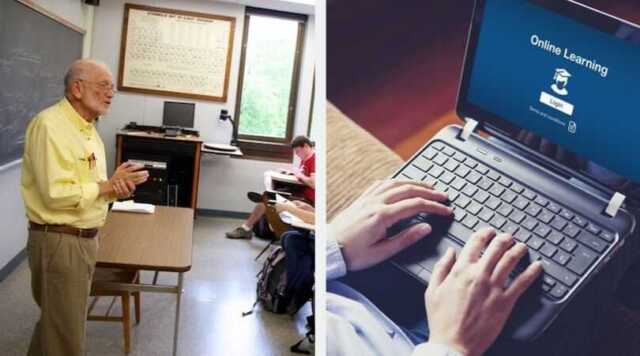
Time Management: Physical Classroom Vs. Online Classroom
Online classroom takes the point here as students find themselves more flexible while attending classes in the virtual setting. Also, since virtual classes can be attended anytime and anywhere, students do not spend extra time commuting back and forth. At the same time, it’s also evident that traditional learning methods involving in-person teaching and hands-on training from an expert will always be necessary in certain circumstances.
Social Skills: Physical Classroom Vs. Online Classroom
The idea of being put into a class with people of all different backgrounds and personality types allows for countless social opportunities that are usually not available in an online classroom. The online classroom can be accessed at any place or time, meaning that students don’t all need to be in the same physical place to take the same course.
Final Comparison
You Might Also Like: Best Free Online Courses With Certificates
Both online classrooms and physical classrooms have their advantages and disadvantages. The thought process of a student plays an important role in deciding which one is better for him or her. Online learning has gained immense attraction as it allows anyone to pursue learning without having to quit the job or to travel distances to learn a new course. This advanced form of learning allows students to get et the convenient career training they need, exactly when they want it.
- Online Classroom
- Physical Classroom
- Time Management
Related Articles
Brain-computer interfaces: the future of communication towards a more accessible world, balancing ai and workforce: 9 pronged strategy to reduce job loss, fashion to function: the seamless evolution of wearable tech, stay connected.

Latest Articles
our aim is to bring you the latest and the best in technology. Covering the latest trends and the latest news, the best technologies, the best apps, the best softwares, the best gadgets.. ALL THINGS TECH.
Website Technical Support by 24x7remotesupport
© Copyright - 2023
woocommerce support
Is online education good or bad? And is this really the right question?
Associate Professor, Warner School of Education, University of Rochester
Disclosure statement
From 1995-2002, Eric Fredericksen was a Principal Investigator for grants received from the Alfred P. Sloan Foundation for ALN (Asynchronous Learning Environments). Eric is a member of the Board of Directors for the Online Learning Consortium (formerly Sloan Consortium), the professional society in higher education focused on quality online education. In 2013, he was honored as a Sloan-C Fellow.
View all partners

For the past twenty years, I’ve heard this question asked many times about online education. It might be tempting for enthusiasts to say “of course it is good,” but I see this as a kind of “trick question.” We should consider asking this question in the context of the traditional classroom.
Have our experiences in traditional classroom been stellar? All of us have had great classes in traditional settings and perhaps some that were not. I would suggest that quality and effectiveness of learning are not tied to “mode” of instruction.
In the same way that we can have good (and not so good) traditional classroom courses, we can also have good (and not so good) online courses. Further, re-conceptualizing and converting a traditional classroom course to an online course doesn’t necessarily make it better or worse.
What does the research tell us? And what are the lessons for teaching – and learning – in the future?
Research about online education
An abundance of studies have examined online education. They explore effectiveness through a number of criteria including satisfaction, retention and achievement.
An objective review published by the American Educational Research Association ( How Does Distance Education Compare with Classroom Instruction? A Meta Analysis of the Empirical Literature ) examined the literature between 1985 and 2002.
The authors analyzed 232 studies at all academic levels (K-12 and higher education) examining achievement (based on 57,019 students), attitude (based on 35,365 students) and retention (based on 3,744,869 students) outcomes. This meta-analysis highlighted that some applications of online education were better than classroom instruction and some were worse.
Another notable analysis was published by the US Department of Education in 2010. The Evaluation of Evidence-Based Practices in Online Learning: A Meta-Analysis and Review of Online Learning Studies found that, on average, students in online learning conditions performed modestly better than those receiving face-to-face instruction.
What should we conclude from this?
I believe it tells us that online learning can be effective – but that alone is not a guarantee that it will be effective. It is not predetermined that online education is better (or worse) than a physical classroom.
Perhaps a more important question to ask is, “ How can online education be effective?”
Developing an online course
After two decades of work in and dedication to this field, I believe that we can positively impact the learning experience for students in online courses. A vital aspect of this is the support and assistance provided to faculty who are designing online courses and that we openly discuss the advantages and constraints of this “type of classroom”.
Effective online courses are developed through the systematic design of instruction with emphasis on the achievement of course learning objectives. This rigorous approach to course development and the creation of learning activities (which vary by course) is fundamental to create an effective learning environment and increases the potential for student learning and their construction of new knowledge.
Thoughtful course planning takes best practices (e.g., consistency of course interface and similarly structured course modules) into account and should be complete prior to the start of the course. In one research study it was interesting to note that faculty who go through the process acknowledge that this conscientious approach to pedagogical review also has positive impact in traditional classrooms.
Admittedly, one great advantage of online learning is the enhanced access for students: removing the constraint of commuting to a specific location at a certain time. Annual studies document that millions of students are able to enroll in online courses. But what are the educational advantages of the online classroom?

A common misperception of online education has been that it is an isolating experience for students. In fact, research studies that I have conducted with colleagues show quite the opposite.
Through asynchronous discussion boards, there can be increased interaction, both in quantity and quality, with and among students. These class discussions are not constrained to a small window of time but can transpire over a week or two. This environment allows all students to engage and actively participate in the discussion.
Compare this to a traditional classroom where the discussion might be dominated by a subset of students, while the rest of the class is passive. Every online student can have a voice and be heard. In addition, expanding the time for discussion permits students to reflect and explore additional information, thoughtfully consider the views of their classmates, and then take the time to construct their own contribution, which can lead to higher quality responses.
Another advantage is the ability to facilitate peer review – a beneficial instructional strategy for learners to share their individual views and knowledge with their classmates regarding papers or projects. This feedback benefits the student author and the student reviewer. Managing peer review is significantly easier in my online classroom (a discussion board enables exchanges) compared to my physical classroom with the corresponding constraints, where students would need to bring hard copies of their work to distribute to their classmates and then need to create an additional event to somehow exchange feedback.
Focus on learning
This is not meant as a criticism of the traditional classroom. I have enjoyed teaching in physical spaces for more than 25 years and found the experience rewarding and valuable. I will continue to do so. But I believe we need to be careful not to romanticize the traditional classroom.
Not all traditional learning experiences are equal. There is a significant difference between a lecture in a large auditorium with hundreds of students and a small seminar room with 15 students.
The physical classroom has one advantage – the “spontaneity” of the discussion that can occur. These occasions can be wonderful learning opportunities. This lack of spontaneity has been a constraint in online classes due to the limitations of required bandwidth for live (synchronous) web conferencing. However, some of the technological challenges have recently been alleviated and I am able to complement my online courses with class discussions where students can see and hear each other, regardless of their physical location.
So what’s the future for online classes? My hope is that we continue to evolve different models of online learning. The spirit of “blended” or “hybrid” online courses strives to capture the best of online with the best of traditional classroom experiences.
Ultimately, I believe we will progress and develop instruction to the point where these historically based distinctions and categorical terms will blur and become less meaningful, and we will simply just focus on learning.
- Online education

Head, School of Psychology

Senior Lecturer (ED) Ballarat

Senior Research Fellow - Women's Health Services

Lecturer / Senior Lecturer - Marketing

Assistant Editor - 1 year cadetship
- Skip to Nav
- Skip to Main
- Skip to Footer

Why PE matters for student academics and wellness right now
Please try again
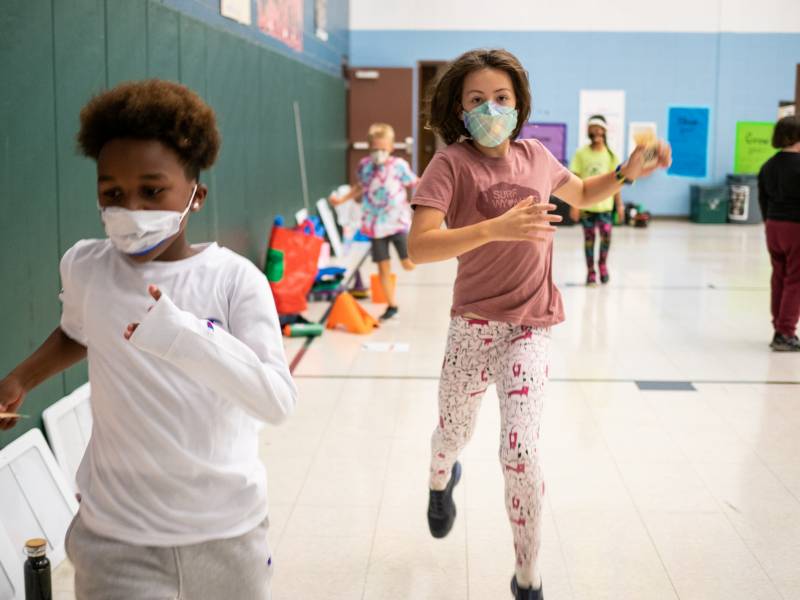
This story about PE teachers was produced by The Hechinger Report , a nonprofit, independent news organization focused on inequality and innovation in education. Sign up for Hechinger’s newsletter .
Amanda Amtmanis, an elementary physical education instructor in Middletown, Connecticut, handed out cards with QR codes to a class of third graders, and told them to start running.
The kids sprinted off around the baseball field in a light drizzle, but by the end of the first lap, a fifth of a mile, many were winded and walking. They paused to scan the cards, which track their mileage, on their teacher’s iPad and got some encouragement from an electronic coach — “Way to run your socks off!” or “Leave it all on the track!”
A boy in a red Nike shirt surged ahead, telling Amtmanis his goal was to run 5 miles. “Whoa, look at Dominic!” another boy exclaimed.
“We don’t need to compare ourselves to others,” Amtmanis reminded him.
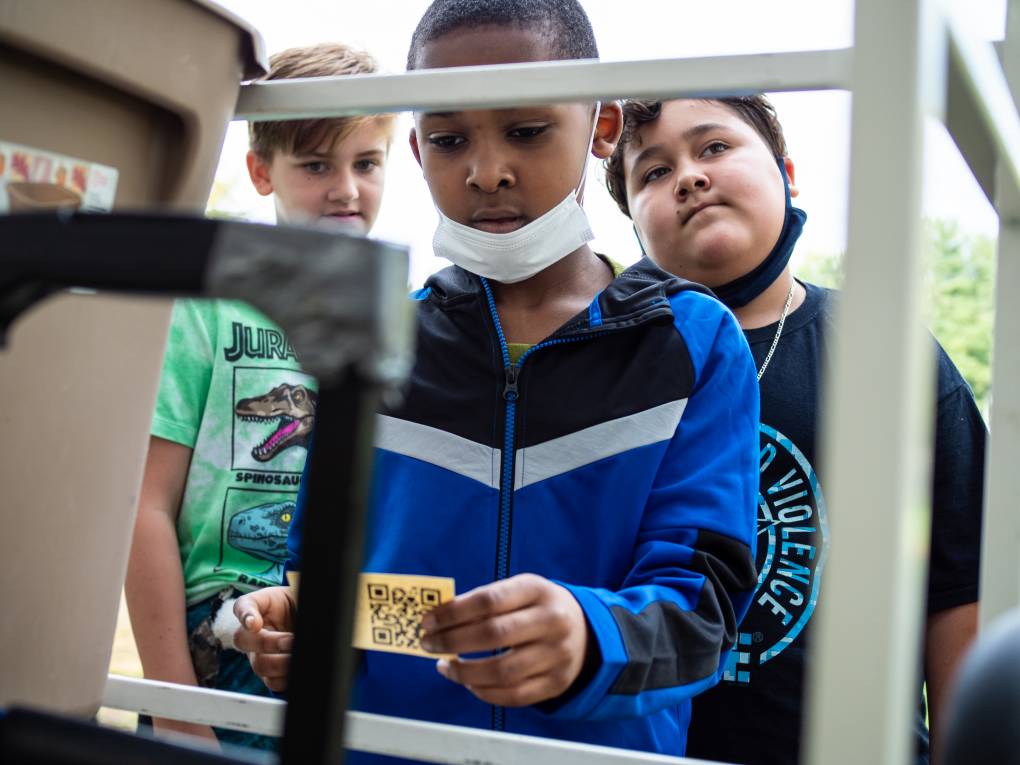
The third graders finished a third lap, alternating running and walking, and were about to start on a scavenger hunt when the rain picked up, forcing them inside. Amtmanis thanked her students for their willingness to adjust — a skill many of them have practiced far more often than running these past 18 months.
The full impact of the pandemic on kids’ health and fitness won’t be known for some time. But it’s already caused at least a short-term spike in childhood obesity Rates of overweight and obesity in 5- through 11-year-olds rose nearly 10 percentage points in the first few months of 2020.
Amtmanis’ “mileage club,” which tracks students’ running, both in and out of school, and rewards them with Pokémon cards when they hit certain targets, is an example of how PE teachers around the country are trying to get kids back in shape.
But inclement weather isn’t the only thing PE teachers are up against as they confront what might be called “physical learning loss.” Physical education as a discipline has long fought to be taken as seriously as its academic counterparts. Even before the pandemic, fewer than half the states set any minimum amount of time for students to participate in physical education, according to the Society of Health and Physical Educators (SHAPE), which represents PE and health instructors.
Now, as schools scramble to help kids catch up academically, there are signs that PE is taking a back seat to the core subjects yet again. In some California schools, administrators are shifting instructional minutes from PE to academic subjects — or canceling class altogether so PE teachers can sub for classroom teachers; in others, they’re growing class sizes in the gym, so they can shrink them in the classroom.
Meanwhile, innovative instructors like Amtmanis, who has worked in her district for more than 20 years, are struggling to get their ideas off the ground. Over the summer, the principal of Macdonough Elementary, one of two schools where Amtmanis teaches, approved her request to participate in another running program called The Daily Mile, in which kids walk or run 15 minutes a day during school hours.
Daily running breaks “boost attentiveness, which has positive effects on academics,” Amtmanis argued.
But two weeks into the school year, not a single teacher had bought into the idea.
“The issue is their packed schedule,” Amtmanis said.
Last year, many schools conducted gym class remotely, with students joining in from their bedrooms and living rooms.
The online format presented several challenges. Many students lacked the equipment, space, or parental support to participate fully. And many instructors grappled with how to teach and assess motor skills and teamwork online.
Though instructors found creative ways to keep students moving — substituting rolled-up socks for balls, and “disguising fitness” in scavenger hunts and beat-the-teacher challenges — they still fretted that online gym wasn’t giving students the same benefits as in-person classes.
Compounding their concern was the fact that many students were also missing out on recess and extracurricular sports.
In a March 2021 survey conducted by the Cooper Institute, maker of the popular FitnessGram assessments, close to half the PE teachers and school and district administrators responding said their students were “significantly less” physically active during their schools’ closure than before it.
Schools that reopened last year faced their own set of challenges, including bans on shared equipment that made even a simple game of catch impossible. Schools that were open for in-person learning were also much more likely to cut back on PE instructional time, or eliminate it altogether, the survey found.
The consequences of these reductions in physical activity are hard to quantify, especially since many schools suspended fitness testing during the pandemic and have yet to resume it, but some PE teachers say they’re seeing more kids with locomotor delays and weaker stamina than normal.
“The second graders are like first graders, and some are even like kindergarteners,” said Robin Richardson, an elementary PE instructor in Kentucky. They can jump and hop, she said, but they can’t leap. They’re exhausted after 20 seconds of jumping jacks.
An unusually high number of Richardson’s first graders can’t skip or do windmills. Some lack the spatial awareness that’s essential to group games.
“They don’t know how to move without running into each other,” she said.
Other instructors are seeing an increase in cognitive issues, such as difficulty paying attention or following directions, particularly among kids who remained remote for most or all of last year.
Kyle Bragg, an elementary PE instructor in Arizona, has seen kids sitting with their backs to him, staring off into space when he’s talking. “I say ‘Knees, please,’ so they spin around to face me,” he said.
And some PE teachers say their students’ social-emotional skills have suffered more than their gross motor skills. “They forgot how to share; how to be nice to each other; how to relate to each other,” said Donn Tobin, an elementary PE instructor in New York.
PE has a key role to play in boosting those skills, which affect how kids interact in other classes, said Will Potter, an elementary PE teacher in California.
“We’re uniquely situated to handle the social-emotional needs that came out of the pandemic, in a way classroom teachers are not,” Potter said.
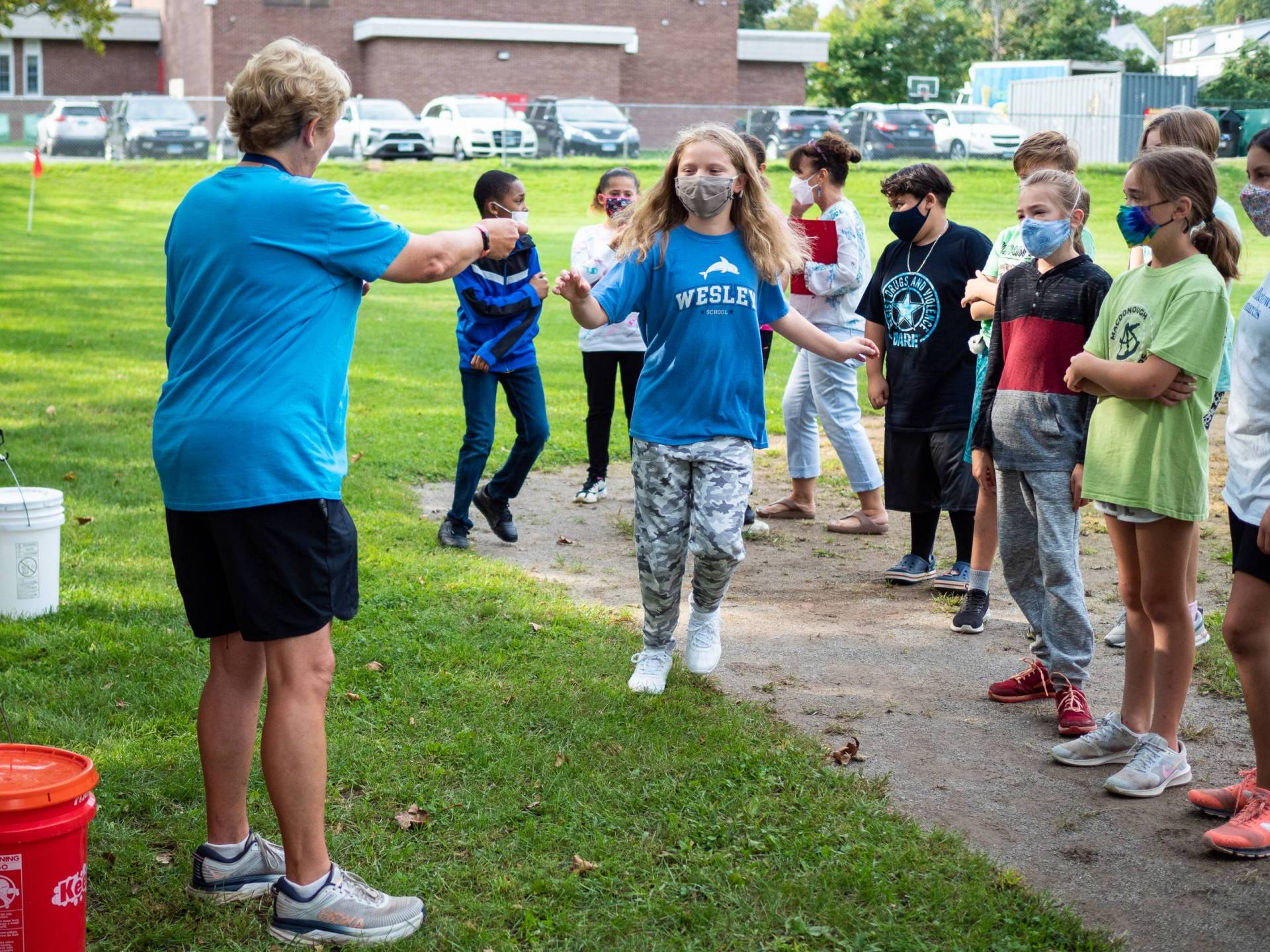
Amtmanis, for her part, worries about her students’ mental health. She sees the little signs of strain daily — the kid who got upset because he couldn’t pick his group, for example, and the one who was distressed that his Mileage Club card had gotten mixed up in the front office.
“Their emotional reserves are low,” she said.
Yet not all instructors are reporting drops in their students’ fitness and skill development. Teachers in some middle- and upper-income districts said they haven’t noticed much of a change at all. In some communities, families seemed to spend more time outdoors.
“We saw the skyrocketing sale of bicycles, we saw families going for walks,” said Dianne Wilson-Graham, executive director of the California Physical Education and Health Project.
But in Title I schools like Macdonough, where more than half the students are low-income, some kids didn’t even have access to a safe place to exercise or play during school closures.
“Not only are they not in soccer leagues, but sometimes they don’t even have a park,” Amtmanis said.
Amtmanis came up with the idea of doing the Daily Mile after spring fitness tests revealed drops in her students’ strength, flexibility and endurance.
But many schools still aren’t sure how much physical learning loss their students have experienced as a result of the pandemic. Most schools pressed pause on fitness testing last year, and some elementary-school instructors are reluctant to restart it. They say the tests aren’t valid with young children, even in ordinary times, and argue the time they take could be better spent on Covid catch-up.
Andjelka Pavlovic, director of research and education for the Cooper Institute, said its tests are scientifically proven to be valid for students who are 10 and up, or roughly starting in fourth grade.
Fitness testing requirements vary by state, county or even district. Some states specify how often students must be tested; others leave it largely to the teacher.
Bragg, the Arizona teacher, said he has put testing “on the backburner” because “right now it’s not at the forefront of what’s important.”
Richardson said she is avoiding testing because she doesn’t want to use up precious instructional time or demoralize her students. “I want my kids to enjoy movement,” she said. If they perform poorly on the tests, “they may not feel as strong.”
In Connecticut, where schools are required to test fourth graders’ fitness annually, Amtmanis approached testing cautiously last year. She didn’t want to embarrass her students, so she made it into a series of games.
Instead of Sit-and-Reach, they had a “flexibility contest,” in which kids broke into teams for tag then had to perform stretches if they were tagged. She measured the distances stretched with curling ribbon, tied the ribbons together, and attached a balloon to the end. The team whose balloon soared the highest won fidget putty.
Pushups became a Bingo game, with the center space representing pushups.
“My goal was to get through it without ever using the words ‘fitness” or ‘testing,’” she said.
As the pandemic drags on, some instructors are taking a similar approach to fitness remediation and acceleration.
Bragg likes a warmup called “ Touch Spots ,” in which first graders listen as the instructor reads off the name of a color, then run and touch a corresponding dot on the floor. It works on reaction time, cardiovascular endurance, spatial awareness and sequencing — but the kids don’t know that.
“Students are having so much fun that they don’t realize how much fitness they are doing,” Bragg said.
Differentiation — tailoring instruction to meet individual students’ needs — has become even more essential, with former remote learners often lagging behind their in-person peers, Bragg said.
When playing catch, for example, he offers his students different sized balls — the smaller ones are more challenging.
Potter, the California teacher, spent the first two weeks of school teaching his students how to connect with their partners, stressing the importance of eye contact and body language.
“When you’re on Zoom, you look at the camera to make eye contact,” he said. “It’s a very different environment.”
Bragg reminds his students how to include kids who are standing on the sidelines, modeling excited body language and tone of voice. Lately, he’s noticed that kids who were remote last year are being excluded from groups.
“Social interaction needs to be practiced, just like how to throw a ball,” he said.
Richardson, the Kentucky PE teacher, is trying to build up her students’ stamina gradually, through progressively longer intervals of exercise.
But she works in a school with pods, so she sees each group of kids for five consecutive days, every third week. The two weeks in between, she has to hope that teachers will provide recess and “movement breaks.” She’s trying to get them to give kids breaks “when they get glassy-eyed and frustrated.”
Recently, Richardson was at a staff training session at which depleted teachers were “popping candy in the back.” When she raised her hand and requested a break in the training, her colleagues cheered. She told them to remember how they felt when their students return to the building.
“I always say, ‘If your bum is numb, your brain is the same,’” she said.
Convincing classroom teachers to set aside more time for movement can be challenging, though. As students return from months of online learning, teachers are under enormous pressure to get them caught up academically.
Kate Cox, an elementary and middle-school PE teacher in California, wishes schools would “realize what they’re missing when they cut PE because of learning loss in other areas.” Physical education is “readying their minds and bodies to be more successful in other areas,” Cox said.
Terri Drain, the president of SHAPE, argued that schools fail students when they treat physical learning loss as less serious than its academic counterpart.
“In the primary grades, children develop fundamental motor skills, such as throwing, catching, running, kicking and jumping,” she said. Unless schools commit to helping kids catch up, “the impacts of this ‘missed learning’ will be lifelong.”

In Connecticut, Amtmanis hasn’t given up on convincing teachers to carve out time for the Daily Mile. She recently sent them a list of suggestions on how to fit 15 minutes of running into the day, including by incorporating it as an active transition between academic blocks.
“While it may seem like there aren’t minutes to spare,” she wrote, “the energizing effect of the active transition should result in more on-task behavior and more efficient working.”
In the meantime, Amtmanis plans to keep using the mileage club to motivate her students to run and to monitor their progress.
“I don’t want to call attention to the fact that not everyone is fit,” she said. “This is an unobtrusive way to keep the data.”
Teaching in a pandemic: a comparative evaluation of online vs. face-to-face student outcome gains
- Open access
- Published: 17 May 2024
- Volume 3 , article number 54 , ( 2024 )
Cite this article
You have full access to this open access article

- Helen Onyeaka 1 ,
- Paolo Passaretti 1 , 2 &
- Jaimie Miller-Friedmann 3
245 Accesses
Explore all metrics
The COVID-19 pandemic forced the education sector to transform significantly in order to support students across the world. Technology played a crucial role in enhancing and adapting traditional learning to digital resources and networks, which are now an essential component of education. However, there is concern about the quality of teaching and its effectiveness in remote teaching due to the lack of real-life feel of more traditional face-to-face education. Our study analysed two separate groups of students enrolled in the same course but provided with either face-to-face or remote teaching. The results show that there is no statistically significant difference in students’ performance or gain, even for laboratory work and resulting reports. However, there was a statistically significant difference in Turnitin scores between these groups, with the remote students having higher levels of plagiarism compared to the traditional face-to-face students. These results support the theory that remote teaching can be a valid alternative, if not a substitute, to face-to-face teaching in the future. The study’s findings are expected to help instructors who are thinking about providing programs through blended learning in the post-pandemic era.
Similar content being viewed by others
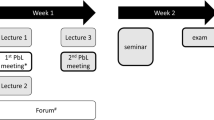
A simple approach of applying blended learning to problem-based learning is feasible, accepted and does not affect evaluation and exam results—a just pre-pandemic randomised controlled mixed-method study

Comparative Study Between Traditional Learning and Digital Learning Amid the COVID 19 Pandemic
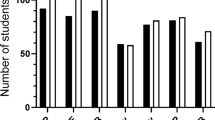
Face-to-face vs. blended learning in higher education: a quantitative analysis of biological science student outcomes
Avoid common mistakes on your manuscript.
1 Introduction
The COVID-19 pandemic has drastically changed the world. One of the sectors that has experienced a significant transformation in higher education [ 1 , 2 ]. The emergence of the COVID-19 pandemic and the resulting isolation necessitated a drastic change to digitalization in education worldwide [ 1 ]. The profound effects of the pandemic on students have not yet been fully realized, but short-term ramifications include an inability to socialize or work in groups, no access to campus-based classrooms or laboratories, and a cessation of ‘normal’ university life [ 3 , 4 ]. Whilst a wide array of technological advances has given educators the opportunity to engage in non-traditional classroom techniques, the COVID-19 pandemic required educators to learn online pedagogical methods and to quickly adjust to the ‘new normal’ [ 5 ]. For most people, the COVID-19 pandemic and ensuing lockdowns were unique experiences, however, permanently changed the nature of how we work and learn, by proving that working and learning from home are viable alternatives to attending classes or meetings in person. Even now, as the threat of the pandemic abates, hybrid teaching and learning has become a necessary tool in pedagogical content knowledge [ 4 ]. Online and hybrid pedagogies are not necessarily new concepts, but they are novel in the context of normative university education, and especially with regard to courses that require practical application of conceptual learning, like laboratories [ 6 , 7 ]. During the lockdown, educators were forced to shift their teaching online, often without any training or understanding of how the delivery of content must change [ 5 , 8 , 9 ]. Of particular concern to science educators in higher education was how laboratory techniques could possibly be taught without hands-on learning. These concerns were additional to traditional issues in teaching science, like the possibility of plagiarism, or a student falling behind in classwork. Therefore, it is crucial to understand whether there are significant differences in conceptual gains between students who attend lecture/laboratory courses in a face-to-face (F2F) format versus those who attend virtually. To address this question, we studied the conceptual gains of F2F and remotely connected students enrolled in the same course by comparing their final exam, lab report and Turnitin scores of all students.
2 Literature review
A variety of technologies have enabled us to enhance and adapt traditional learning approaches with computer-based resources [ 10 ]. Educators have been encouraged to develop technology-based learning media capable of meeting school curricula and national standards [ 11 ]. The utilization of the latest available technologies, such as cloud servers, 3D printing, Augmented Reality (AR), Smartboards, Video conferencing, FlipGrid, Hybrid Learning and Adaptive Learning Platforms, in science education has been widely applauded as innovative [ 12 , 13 ]. However, most of the scholarly work on technology use in science education was studied or published prior to the pandemic, and many of these studies fold technology into traditional classroom teaching. The pandemic has created an immediacy for robust studies that prove the efficacy of fully online and hybrid science education.
Whilst some educators have been concerned about plagiarism rates and how online education may affect these rates, Ison [ 14 ] debunked the myth that online institutions and learning methods contributed to the prevalence of plagiarism. The study proved that traditional schools had more extreme cases of plagiarism compared to online institutions. Four years later, Ison published a paper on differences in plagiarism between world cultures, in which he showed that Western European students (including those in the UK) plagiarise far less frequently than their counterparts in India and China [ 15 ]. In this paper, he notes that cultural differences account for some of what would be considered plagiarism in the UK,i.e., ‘significant differences were found to exist between Chinese and Western scholars in their perceived requirement to acknowledge authorship of source documents’ [ 15 ]. Turnitin also needs to be considered for what it actually does, as a program, although most universities now require its use in grading as a shortcut to sorting out plagiarised from original papers. A recent study by Gallant, et al., describes the use of Turnitin in determining the originality of laboratory reports,this study found that most of the text flagged by Turnitin was reworded from the textbook, and could not be described as plagiarism (Gallant et al. 2019). Lab experiments are an intrinsic part of science education, and recreating the lab experience online has proved to be a popular challenge [ 16 , 17 , 18 , 19 , 20 ]. Several distinct factors such as reduction in equipment needs, availability at any time from anywhere, and the opportunity for students to learn at their own pace while exploring difficult or interesting concepts, have been highlighted as benefits of using virtual experiments in education [ 21 ]. These virtual laboratory sessions can be utilized by both undergraduate and postgraduate students as lab sessions follow the same principles and only vary in complexity depending on the level of studies [ 22 , 23 ]. However, opinions on how to use virtual experiments in science and their impact on students’ learning outcomes have largely varied. In a review of recent advances, it was reported that students attain a deeper understanding of science when virtual labs are combined with real hands-on labs [ 20 ] and are shown to increase students' grasp of key laboratory techniques [ 24 ]. For instance, virtual labs have been used to carry out dangerous experiments or experiments impossible in real-life situations [ 25 ].
The responses of students to online labs in published literature reflect negative concerns. In a survey done to assess the experience of students who had participated in an online lab exercise, students lamented over missing out on specific lab activities they had long anticipated they would have participated in person. A major concern raised was the lack of access to their lab instructor during the exercise, although the instructor’s e-mail was readily available to the students [ 26 ]. Scheckler [ 10 ] asserted that the virtual lab experience removes participants from the reality of the physical lab, where specimens can be handled physically. Another negative aspect of online labs is the inherent technical problems such as website failure, access to the internet, use of specific technological tools and applications to access the lab, as well as accuracy and continued existence of hyperlinks associated with online labs glossary [ 10 ].
Overall feedback in published literature from students and attitudes towards virtual education has been positive. Students' reception of virtual laboratories has been positive [ 27 ] and they highlighted instant feedback, flexible access, and test–retest reliability as the major benefits of virtual education [ 28 , 29 , 30 ]. Similarly, students have reported increased engagement with laboratory materials and quizzes and knowledge progression during virtual labs in comparison to prior physical laboratory experiences [ 31 ]. Although virtual education has the potential to revolutionize face-to-face (F2F) learning and teaching in higher institutions [ 12 , 13 , 29 ], it has been criticized for lacking real-life feel that face-to-face education offers. Research has shown that face-to-face education plays a critical role in education, especially in science education [ 32 , 33 ]. It has been hypothesized that with augmented reality, sensorial devices, live videos, and interactive videos, technologies used for virtual education can be improved to have a life-like experience while retaining all the benefits a virtual education offers [ 34 ].
From a technological standpoint, introducing virtual learning technology into the education process demands modifications of the existing protocols present in the traditional learning approach [ 11 , 25 , 35 ]. For instance, to input new learning content, educators must at least understand the underlying technology behind virtual learning technology [ 11 , 25 , 35 ]. This has shown to be particularly challenging as creating realistic virtual models of objects requires cooperation between experts on respective subjects and highly skilled programmers and graphic designers [ 11 , 25 , 35 , 36 ]. To be most effective in bringing a traditional science course online, teachers must be trained in the newest technologies and have the time to create the necessary resources to make their virtual courses as successful as their face-to-face teaching.
While it is reasonable to be excited about all the innovative technologies revolutionizing education, it is essential to carefully consider whether virtual education is genuinely beneficial to students’ learning. Several studies have attempted to evaluate the specific benefits of virtual education, particularly virtual labs [ 36 , 37 , 38 , 39 ]. The effectiveness of student learning in both virtual and face-to-face education (laboratory learning activities) have produced contradictory results [ 36 , 37 ], often due to the lack of a control group. Utilizing control groups to evaluate students’ performance in virtual and face-to-face education has produced contrasting results. For example, an investigation that utilized control groups suggested no significant differences in students’ performance in two learning formats, such as traditional and stimulated lab [ 36 ]. On the other hand, another study with a higher sample size proposed that virtual education significantly improved students’ learning outcome gains [ 39 ]. Other studies have also evaluated the benefits of utilizing virtual education in lecturing, assessment, and quizzes [ 39 , 40 , 41 , 42 ]. The emerging picture suggests there were positive achievements in students’ gains with regard to the classroom, but not laboratory work. Interestingly, these outcome gains were independent of class size and subject, and similar gains were achieved with the use of technology and non-technology-dependent techniques [ 39 , 40 , 41 ].
However, significant disagreement exists among science educators regarding the means and purpose of the laboratory component in science courses [ 36 , 37 ]. This varying opinion has become the single biggest factor in the debate regarding the efficacy of non-traditional learning versus traditional learning [ 16 , 18 ]. In a meta-analysis study of trends in virtual and traditional learning, it was revealed that before 2002, less than 70% of the published studies favored online education, while in studies published after 2003, 84% of the studies favored online education [ 43 ]. When focusing on empirical studies after 2005, there is a similar trend regarding favorability and support for virtual and remote learning. The majority of studies reviewed claimed that students’ outcome gains in virtual education were equal to or greater than achievement in face-to-face education [ 44 ].
Not only has virtual education become more prevalent in recent times, but it has also made it easier to accommodate and manage the increasing numbers of students enrolling in undergraduate and graduate programs [ 2 , 11 ]. In a similar vein, the need to find alternative means of instructing students and assessing students’ performance has increased, as one teacher is insufficient to meet the needs of so many students [ 45 ]. Most significantly, there is also a need to ensure that these alternative means have the same effects and outcomes as attained in the face-to-face (F2F) methods of teaching, learning, and assessment, in light of the recent pandemic.
Our study aims to compare two education models in terms of student learning outcomes. Specifically, we compared groups of students, one receiving the lecturer completely virtual and the other attending the class in a traditional face-to-face (F2F) fashion. The study’s findings are expected to aid instructors who are contemplating providing programs using blended learning in the post-pandemic period.
3.1 Teaching module overview
This study is based on the teaching module named “Food and Microbes” of the School of Chemical Engineering at the University of Birmingham, class 2020/21. This module revolves around the current and existing knowledge of food microbiology, introducing students to the basic concepts of epidemiology and the control of infectious diseases, as well as factors affecting food spoilage, the survival of pathogens and the association of specific microbes with certain foods. A variety of teaching methods are employed in this teaching module. Although most of the course is delivered in lecture format, in practice this includes a mixture of formal teaching, case studies, practical exercises, and a laboratory practical. A feature of the course is the inter-relationship between pure and applied microbiology and its application to industrial processes and the understanding of food safety.
3.2 Participants
The 2020/21 class was composed of 30 postgraduate students. Due to the number of students (80% Chinese, 10% British, and the rest from Africa and America) and the experimental nature of the comparative groups, we consider this to be a case study. While 18 students could attend the lecture in person, the remaining 12 students were enrolled from China, and could not travel to the UK to attend the course due to COVID-19 pandemic restrictions. Therefore, the two groups were named face-to-face (F2F) and Remote, respectively. These circumstances forced the teaching sector to adjust and adapt the teaching approach, as well as students’ learning. Moreover, we considered these conditions ideal to record all possible information and compare the teaching and learning between the two groups. In this case, while F2F students were able to attend the class in person, the Remote group was attending the lecture from China via Zoom streaming. For the scope of this study, there was no further categorization (i.e. nationality, gender, etc.) of the students involved. The lecture was streamed live so that all students were participating at the same time. Moreover, all students had access to the teaching material on a dedicated Canvas page. Canvas is a popular learning management system (LMS) used by many universities and educational institutions around the world. It provides a platform for instructors to manage course materials, assignments, quizzes, discussions, and grades, while also offering students a centralized place to access course content, submit assignments, communicate with instructors and peers, and track their progress. Canvas is known for its user-friendly interface and robust features, making it a widely adopted choice in higher education. During the course, all the students participated in the formative quizzes, lab report and final assessment. All marks were uploaded on the Canvas page, which facilitated the collection of the data used for this study.
3.3 Data collection and analysis
We employed a quantitative analysis approach to evaluate the educational outcomes of online vs. face-to-face teaching methods. Data were collected through formative quizzes, summative lab reports, and final exams, and analyzed using independent sample t-test to compare the mean scores of the two independent groups (F2F and Remote) across different assessments. The choice of t-tests is appropriate for comparing the means of two groups when the data are assumed to be normally distributed.
The data of F2F and Remote students employed in this study were stored on the Canvas page of the course and collected through the tutor account. Data were exported and organised in an Excel spreadsheet. Subsequently, data were analysed with Prism GraphPad 9 software. Multiple comparisons with independent sample t-tests were performed. Levene’s test was performed using the average scores of quizzes, final exams, lab reports, and Turnitin scores for both F2F and Remote groups to assess the equality of variances. The test is used to assess the assumption of equal variances between the two groups, which is a necessary condition for conducting independent sample t-tests. Statistical significance was set at p < 0.05. In our analysis, we focused on comparing average scores, median values, and standard deviations (SD) across different assessments (quizzes, final exams, and lab reports) between face-to-face (F2F) and remote learning groups. A two-way ANOVA was conducted to explore the interaction effects between the type of learning and student performance metrics. This was utilized to examine the interaction effects between the type of learning delivery (F2F vs. Remote) and the students' performance metrics across different assessments. This approach helps to understand if the mode of delivery impacts the outcome variables.
The exam was conducted online by all students due to COVID-19 restrictions. The exam was timed and consisted mostly of open-ended questions to minimize the possibility of copying and pasting from external sources. Furthermore, question pools were utilised and set to randomise questions, ensuring that students do not answer a uniform set of questions. Students were given clear instructions on how to access the exam and how much time they had to complete it. The exam format and questions were reviewed by the instructors to ensure that they were relevant to the course content and could effectively assess student knowledge and understanding. In addition, Turnitin was used to check for instances of plagiarism, improper citation, or unoriginal content in student submissions. This software provides a similarity score indicating the percentage of text in the document that matches existing sources. This helps instructors ensure academic integrity and promote originality in student work. To ensure that the exam is taken by the students themselves and not a proxy, all students were mandated to join an exam Zoom meeting, leave their cameras on, but be muted throughout the duration of the exam.
3.4 Ethical considerations
While no formal approval was required due to the nature of the study, we followed strict protocols to ensure participant privacy and obtained informed consent from all students involved. Data anonymization was rigorously implemented; personal identifiers were replaced with unique codes, and demographic details that could potentially reveal participant identity were carefully obscured. The handling of data was conducted with utmost security—stored on encrypted servers with access strictly limited to authorized personnel, and secure protocols were employed for any data transfer. Informed consent was vital to each of the participant engagement process as they were thoroughly briefed about the study's aims, methods, and their rights, ensuring they understood their participation was entirely voluntary and could be withdrawn at any time.
The students attending the module, “Food and Microbes”, were split into two groups based on the type of enrolment, F2F or Remote. During the course, both groups of students were marked via numerous formative quizzes to test their improvement, and then evaluated via a summative lab report and final exam. Two-way between group ANOVAs were conducted on each of these outcome scores—quiz average, summative laboratory report, and final exam—to determine whether there were differences in learning between online and F2F learning groups. In addition, the Turnitin score that is automatically provided by the application Turnitin was analysed to assess the degree to which online students vs. F2F students rely on plagiarism to complete their assignments. These data are presented in Table 1 :
The lab report and the final exam marks shown in Table 1 are the most important since they are essential to pass the class; students must score at least 50% to pass. For quizzes, F2F students had an average score of 83.52 with an SD of 11.26, while Remote students scored an average of 80.18 with an SD of 11.49. The difference was not statistically significant (p > 0.05). The lab report score average for F2F and Remote students was 61% and 65%, respectively. The average score for F2F students was 61.11 (SD = 16.50), and for Remote students, it was 64.67 (SD = 10.44). The difference in scores was not statistically significant (p > 0.05). The final exam score had similar results, with F2F students scoring an average of 79% and Remote students 75%. F2F students achieved an average score of 79.11 (SD = 10.55), compared to Remote students who scored an average of 74.61 (SD = 13.19), again showing no significant difference (p > 0.05). These scores were not significantly different. A notable finding was the difference in Turnitin scores, with F2F students averaging 26.72 (SD = 8.34) and Remote students 40.67 (SD = 8.36), indicating a significant difference (p < 0.05). F2F students have a much higher variance of the data and a statistically significant difference from online students in their Turnitin score. The Turnitin score calculated for the lab report shows a significant difference between the two groups of students. In particular, students attending virtually seem to have a higher level of plagiarism compared to the F2F. Both groups were also subject to several quizzes at the end of each section of this teaching module. Although F2F seems to have a slightly higher score on average, there is no significant difference between the two groups.
4.1 Correlation analysis
The correlation coefficient ranges from − 1 to 1, with values closer to − 1 indicating a strong negative correlation, values closer to 1 indicating a strong positive correlation, and values close to 0 indicating no correlation. From the correlation matrix, we can see that Lab Mark has a strong positive correlation with Exam Score (r = 0.862) suggesting that students who perform well in lab activities tend to score well in the final exam. This implies a consistency in performance across different types of assessments and a weak negative correlation with Turnitin score (r = − 0.199). This weak negative correlation (r = − 0.199) indicates that higher lab scores are slightly associated with lower plagiarism scores. This could suggest that students who engage more authentically with their lab work may be less likely to plagiarize. Turnitin score has a weak negative correlation with Exam Score (r = − 0.239). The weak negative correlation (r = − 0.239) implies that higher instances of plagiarism do not necessarily correlate with higher exam scores, suggesting that plagiarism may not benefit overall student performance. The results suggest that there is a positive correlation between Lab Mark and Exam Score, meaning that students who performed well in the lab also tended to perform well on the exam. However, there is a weak negative correlation between Lab Mark and Turnitin score, indicating that students who performed better in the lab tended to have lower Turnitin scores. The weak negative correlation between Turnitin score and Exam Score suggests that higher Turnitin scores may not necessarily be associated with better exam performance.
4.2 Levene’s test results
The F2F assessment had a mean score of 83.52 when conducted F2F and 79.11 when conducted remotely. The Remote assessment had a mean score of 80.18 when conducted F2F and 74.61 when conducted remotely. These results suggest that the scores were generally higher when the assessments were conducted face-to-face compared to remotely (Table 2 ).
Levene’s test for equality of variances yielded a statistic of 0.397 with a p-value of 0.552. As the Levene's test statistic is 0.397, the value represents the magnitude of the difference in variances between the two groups. A smaller value indicates a smaller difference in variances, suggesting that the assumption of equal variances may hold. As the p-value is greater than 0.05, we fail to reject the null hypothesis, suggesting no significant difference in variances between the F2F and Remote groups. Therefore, the assumption of equal variances holds, validating the use of parametric tests for further statistical analysis.
5 Discussion
The statistical analysis indicates that there were no significant differences in between the F2F and Remote students’ performances on quizzes, the final exam and final laboratory report scores, except for the plagiarism scores. This outcome suggests that remote learning can be as effective as traditional classroom settings in terms of student academic performance. However, the higher plagiarism scores in the Remote group suggest that academic integrity could be a concern that needs to be addressed more rigorously in remote learning environments. The data suggest that there is no statistically significant difference between face-to-face and virtual delivery methods in terms of final marks in the Food and Microbes course. This indicates that virtual teaching could be employed as an alternative or even as the main approach to teaching. However, further research is needed to investigate the effectiveness of virtual teaching on students' well-being and other factors that may affect learning outcomes.
These findings are similar to the study of [ 36 ] which reported no significant difference between performances in a traditional and stimulated food chemistry lab. However, their study only focused on laboratory classes (a traditional hands-on lab and a simulated lab), whereas our study evaluated formal teaching, quizzes and laboratory practical classes. The only significant difference found between these two groups is in the Turnitin score, which implies that Remote students had copied more. Overall, both groups obtained higher marks on quizzes and the final exam, compared to the final lab report. This provides information about the impact of the examination modality. While quizzes and final exams are characterised by multiple-choice questions, the lab report must be written from the ground up. Students are provided with a standard template and general information about how to structure the report and what key information needs to be included. The lower score in lab reports obtained by both groups suggests that this examination modality can be more difficult for students. This could be due to the fact that students are more experienced in learning concepts and providing answers to specific questions, rather than structuring a scientific report. The latter cannot be easily drafted just by knowing the scientific concepts learned during the course. Instead, to write a report it is also necessary to analyse data, organise them logically and comprehensively, as well as writing all the sections ab initio. The lack of significant differences in academic performance between F2F and Remote groups supports the viability of remote learning as a comparable alternative to traditional classroom settings. The significant difference in Turnitin scores points to the need for enhanced strategies to promote academic integrity in remote learning environments. Institutions may need to implement more rigorous checks and balances or provide more education on academic ethics. The strong correlation between lab and exam performance underscores the importance of hands-on activities, even in a virtual environment. Educators should strive to integrate practical, application-based tasks into the curriculum to improve learning outcomes. The slight negative correlation between lab performance and plagiarism indicates that students who are more engaged with coursework may be less inclined to plagiarize. This suggests a need for personalized learning paths and support to enhance engagement and reduce academic dishonesty.
The Turnitin score associated with the lab report is a plagiarism indicator. Higher scores correspond to a high percentage of plagiarised text. In our analysis of Turnitin scores, we recognize that these metrics represent the degree of text similarity rather than direct evidence of plagiarism. Turnitin’s functionality as a similarity checking tool does not definitively distinguish between instances of properly cited work and plagiarized content. Therefore, while higher Turnitin scores observed in remote students suggest increased similarity, this should not be automatically equated with academic dishonesty. It is essential to consider the context of each similarity instance identified by Turnitin to make informed judgments about academic integrity. It is interesting to note that although students are not supervised while writing the lab reports, there is a statistically significant difference between F2F and Remote. This might be indirectly related to the longer distance between students and the institution. Being far away from the university could impact how students are committed to studying, increasing the tendency to copy rather than write lab reports on their own. We can speculate that this could be due to a weaker personal relationship with the lecturer. F2F have a direct and personal interaction with the lecturer, who they might not want to disappoint with a plagiarised report. On the other hand, Remote students might perceive the lecturer just as a virtual tutor, so they do not feel to create any kind of social connection. However, the differences in the Turnitin score could also be unrelated to the remote study approach and be due to other factors not measurable via this study. For example, students' nationality could have played a significant role in this context. As discussed earlier, the Ison study showed that students in China have a different point of view both to plagiarism itself and to those acts which could be considered plagiarism [ 15 ]. The entire online group consisted of Chinese students, and so the reasons discussed in Ison’s paper for plagiarism may apply to this cohort. In addition, other literature notes that Turnitin, whilst useful, tracks similarity, rather than plagiarism. Laboratory reports, as noted by the Gallant, et al., study, will have similarities due to the fact that certain sections of a laboratory report are essentially the same for all students (e.g., method) [ 46 ]. The influence of cultural and educational backgrounds on Turnitin scores warrants consideration, as highlighted by studies like [ 15 ]. Cultural perspectives towards academic writing and citation practices, particularly evident in diverse student populations, can significantly impact Turnitin similarity scores. For instance, in cultures where collective knowledge is valued, there may be a different approach to citing sources and conceptualizing plagiarism. Educational systems also play a role, with variations in emphasis on originality versus collective learning affecting students' writing practices. Therefore, observed differences in Turnitin scores between face-to-face (F2F) and remote students may stem from deeper cultural and educational influences rather than just physical distance. Instructors should recognize and accommodate these diverse perspectives, providing tailored support to foster academic integrity while respecting cultural differences in writing and citation norms. It is important to highlight that similarity scores are not definitive evidence of plagiarism on their own. Instructors need to review the highlighted similarities in context to determine whether they represent legitimate citations, quotations, or instances of improper copying. Additionally, some types of assignments, such as research papers, may naturally have higher similarity scores due to the inclusion of properly cited external sources. The teaching and learning methods described so far are not equal, however, our results show that they can be considered equivalent. Excluding the differences found for the plagiarism, both groups performed equivalently, demonstrating that it is possible to successfully teach and learn a scientific laboratory course remotely. Our study is limited to a specific subject and number of students. It is therefore necessary to study the effect of remote laboratory learning on a larger group and confirm our findings. Moreover, it would be interesting to compare our study with similar approaches in different subjects spanning across human sciences (i.e., history, philosophy, sociology, psychology, etc.) and more analytical subjects (i.e., mathematics, physics, chemistry, etc.).
Remote teaching is not something completely new. Even before the pandemic, many universities were offering 100% online courses, but the pandemic forced schools and universities to accelerate their intentions and improve the teaching methodologies and technologies related to remote teaching. This approach has already shown numerous advantages compared to traditional teaching, such as the possibility of delivering a lecture to a larger number of students without the need for a larger classroom, giving the possibility to students to learn from the most talented and awarded Professors, as well as studying with other students who are far away, without travel. Moreover, students have more flexibility in the way they learn due to the possibility of re-watching recorded lectures, saving the cost of transport to attend university lectures and labs, as well as a reduction in energy costs for the university infrastructures. One of the key challenges encountered during the remote teaching of this course was maintaining student engagement and active participation in the online learning environment. As highlighted by [ 47 ], student engagement is crucial for academic performance in e-learning settings. To mitigate this challenge, we employed several strategies drawn from the literature and our own experiences. Firstly, we intentionally designed interactive learning activities that fostered active student contribution, as emphasized by Rajabalee et al. [ 48 ]. These activities included online discussions, collaborative projects, and opportunities for peer feedback, which have been shown to positively impact student engagement and overall performance in online courses. Secondly, we focused on enhancing learner satisfaction by providing clear communication, prompt feedback, and easily accessible support resources. Rajabalee and Santally [ 49 ] underscore the importance of learner satisfaction in promoting engagement and performance in online modules. We maintained regular communication through multiple channels, offered timely feedback on assignments and queries, and curated a comprehensive set of online resources for students to refer to at their convenience.
Despite these efforts, we acknowledge that the remote learning experience may have presented additional challenges, such as technical difficulties, feelings of isolation, or distractions in home environments. Continuous monitoring, adaptation, and open communication with students were crucial in identifying and addressing these challenges as they arose. By implementing strategies to foster engagement, active contribution, learner satisfaction, and open communication, we aimed to create an effective and supportive online learning environment.
6 Conclusion
According to our study, there is no statistically significant difference between F2F and Remote students’ final marks at the end of the Food and Microbes course that we reported. Therefore, this is an indication that virtual teaching could be employed as an alternative or even as the main approach to teaching. This case study provided important information about the effectiveness of remote teaching in a postgraduate laboratory course. Although the Turnitin score for the two groups significantly differs, the score may not give a definitive understanding of the two groups of students' approach to plagiarism as the Turnitin tool detects only textual plagiarism. Also, the limited number of students involved limits our conclusions. It is important to extend the study to a larger group of students, testing the effects of the same course and its two delivery methods on learning and student performance. This could help to refine the results and provide more insights to improve the remote teaching strategies currently in place.
The Coronavirus pandemic strongly impacted on education at any level. This gave the chance to reshape the approaches to teach, particularly via remote teaching. Although the latter was already known and widely employed by universities and the private sector, the pandemic forced the education sector to rapidly improve and employ the currently available technologies to guarantee the best teaching quality possible. However, to assess whether remote teaching can be considered a viable and robust alternative to F2F, it is still necessary to further investigate its effectiveness on students’ performances as well as students’ well-being.
7 Future research
While the current study was limited to quantitative analysis due to pandemic-related constraints, future research will aim to incorporate qualitative methods such as interviews, focus groups, and possibly case studies in subsequent studies. This will allow for a more holistic evaluation of the educational approaches by capturing the intricacies of student experiences and perceptions that are not readily quantifiable. We believe that integrating both quantitative and qualitative data will provide a more comprehensive understanding of the effectiveness of different teaching modalities.
Furthermore, future research on diversifying assessment techniques holds the promise of enriching our understanding of student learning and engagement. By incorporating a broader spectrum of assessment methods, including formative assessments, project-based assessments, and peer evaluations, educators can gain deeper insights into the multifaceted nature of student progress. Formative assessments offer real-time feedback, allowing for adjustments in teaching strategies and student learning approaches. Project-based assessments encourage practical application of knowledge, fostering critical thinking and problem-solving skills. Peer evaluations promote collaborative learning and self-reflection, essential components of a comprehensive educational experience. Such research could explore the impact of these diverse assessment methods on student motivation, retention of knowledge, and overall academic success.
In the future we would like to explore additional factors influencing student performance in online and face-to-face settings, such as access to resources, level of support provided, and the nature of assessments, providing valuable insights into optimizing remote teaching strategies. Furthermore, conducting longitudinal studies to assess the long-term effects of remote learning on student outcomes and well-being would contribute significantly to understanding the sustainability and efficacy of remote education. Also, future studies could expand the scope by including multiple cohorts or institutions to increase the sample size and enhance the generalizability of the findings. We also aim to explore avenues for responsibly sharing data while protecting participant privacy and adhering to ethical guidelines. This would enhance the reproducibility of our findings and foster collaborative efforts within the research community.
Data availability
The data that support the findings of this study are not openly available due to reasons of sensitivity and are available from the corresponding author upon reasonable request.
Bilecen B. Commentary: COVID19 pandemic and higher education: International mobility and students’ social protection. Int Migr. 2020;58(4):263–6.
Article Google Scholar
Eder R. The remoteness of remote learning: a policy lesson from COVID19. J Interdiscip Stud Educ. 2020;9(1):168–71.
Kedraka K, Kaltsidis C. Effects of the covid-19 pandemic on university pedagogy: Students' experiences and considerations. Eur J Educ Stud. 2020; 7(8).
Onyema EM, Eucheria NC, Obafemi FA, Sen S, Atonye FG, Sharma A, Alsayed AO. Impact of coronavirus pandemic on education. J Educ Pract. 2020;11(13):108–21.
Google Scholar
Martin F, Wang C, Jokiaho A, May B, Grübmeyer S. Examining faculty readiness to teach online: a comparison of US and German educators. Eur J Open Dist E-learn. 2019;22(1):53–69.
Karalis T, Raikou N. Teaching at the times of COVID-19: inferences and implications for higher education pedagogy. Int J Acad Res Bus Soc Sci. 2020;10(5):479–93.
Ilieva G, Yankova T, Klisarova-Belcheva S, Ivanova S. Effects of COVID-19 pandemic on university students’ learning. Information. 2021;12(4):163.
Basilaia G, Dgebuadze M, Kantaria M, Chokhonelidze G. Replacing the classic learning form at universities as an immediate response to the COVID-19 virus infection in Georgia. Int J Res Appl Sci Eng Technol. 2020;8(3):101–8.
Saha SM, Pranty SA, Rana MJ, Islam MJ, Hossain ME. Teaching during a pandemic: do university teachers prefer online teaching? Heliyon. 2022;8(1): e08663.
Scheckler RK. Virtual labs: a substitute for traditional labs? Int J Dev Biol. 2003;47(2–3):231–6.
Lewis DI. The pedagogical benefits and pitfalls of virtual tools for teaching and learning laboratory practices in the biological sciences. The Higher Education Academy: STEM. 2014.
Ayega D, Khan A. Students experience on the efficacy of virtual labs in online biology. In: 2020 The 4th International Conference on Education and E-Learning. 2020.
Faulconer E, Griffith J, Wood BL, Acharyya S, Roberts D. A comparison of online and traditional chemistry lecture and lab. Chem Educ Res Pract. 2018;19(1):392–7.
Ison DC. Does the online environment promote plagiarism? A comparative study of dissertations from brick-and-mortar versus online institutions. J Online Learn Teach. 2014;10(2):272.
Ison DC. An empirical analysis of differences in plagiarism among world cultures. J High Educ Policy Manag. 2018;40(4):291–304. https://doi.org/10.1080/1360080X.2018.1479949 .
Aljuhani K, Sonbul M, Althabiti M, Meccawy M. Creating a Virtual Science Lab (VSL): the adoption of virtual labs in Saudi schools. Smart Learn Environ. 2018;5(1):1–13.
Darrah M, Humbert R, Finstein J, Simon M, Hopkins J. Are virtual labs as effective as hands-on labs for undergraduate physics? A comparative study at two major universities. J Sci Educ Technol. 2014;23(6):803–14.
Hurtado-Bermúdez S, Romero-Abrio A. The effects of combining virtual laboratory and advanced technology research laboratory on university students’ conceptual understanding of electron microscopy. Interact Learn Environ. 2020;31:1126–41.
Swan B, Coulombe-Quach X-L, Huang A, Godek J, Becker D, Zhou Y. Meeting the needs of gifted and talented students: case study of a virtual learning lab in a rural middle school. J Adv Acad. 2015;26(4):294–319.
Sypsas A, Paxinou E, Kalles D. Reviewing inquiry-based learning approaches in virtual laboratory environment for science education. Διεθνές Συνέδριο για την Ανοικτή & εξ Αποστάσεως Εκπαίδευση. 2020;10(2Α): 74–89.
Wong W-K, Chen K-P, Chang H-M. A comparison of a virtual lab and a microcomputer-based lab for scientific modelling by college students. J Balt Sci Educ. 2020;19(1):157–73.
Bassindale T, LeSuer R, Smith D. Perceptions of a program approach to virtual laboratory provision for analytical and bioanalytical sciences. J Forensic Sci Educ. 2021;3(1).
Sergeevna VY, Lilia SS, Nikolaevna VS, Suvonovich EY. Main Trends in the Organization of the Postgraduate Research and Education Process in the Context of Digitalization of Higher Education. In: 2022 8th International Conference on Energy Efficiency and Agricultural Engineering (EE&AE) (pp. 1–5). IEEE. 2022.
Paxinou E, Georgiou M, Kakkos V, Kalles D, Galani L. Achieving educational goals in microscopy education by adopting virtual reality labs on top of face-to-face tutorials. Res Sci Technol Educ. 2022;40(3):320–39.
Chen X, Song G, Zhang Y. Virtual and remote laboratory development: a review. Earth Space Eng Sci Constr Opera Challeng Environ. 2010; 3843–3852.
Gilman SL. Do online labs work? An assessment of an online lab on cell division. Am Biol Teach. 2006; 68(9).
Ghazali AR, Zainodin EL, Madhavan I, Gnanasundram LS, Nisar N, Abd Rashid R, Tang WW. Perception of online teaching and learning (T&L) activities among postgraduate students in Faculty of Health Sciences, Universiti Kebangsaan Malaysia (UKM). Front Educ. p. 166. 2022.
Keeney-Kennicutt W, Winkelmann K. What can students learn from virtual labs? Committee Comput. Chemical Edu. 2013.
Lynch T, Ghergulescu I. Review of virtual labs as the emerging technologies for teaching STEM subjects. In: INTED2017 Proc. 11th Int. Technol. Educ. Dev. Conf. 6–8 March Valencia Spain, 2017.
Perez S, Massey-Allard J, Butler D, Ives J, Bonn D, Yee N, Roll I. Identifying productive inquiry in virtual labs using sequence mining. In: International conference on artificial intelligence in education. pp. 287–298. 2017, Springer, Cham.
Jennifer GA, Thomas MG, Vijay Solomon R. Does virtual titration experiment meet students’ expectation? Inside out from Indian context. J Chem Educ. 2022;99(3):1280–6.
Hofstein A, Mamlok-Naaman R. The laboratory in science education: the state of the art. Chem Educ Res Pract. 2007;8(2):105–7.
Satterthwait D. Why are’hands-on’science activities so effective for student learning? Teach Sci. 2010;56(2):7–10.
Wang J, Guo D, Jou M. A study on the effects of model-based inquiry pedagogy on students’ inquiry skills in a virtual physics lab. Comput Hum Behav. 2015;49:658–69.
Baladoh S, Elgamal AF, Abas HA. Virtual lab to develop achievement in electronic circuits for hearing-impaired students. Educ Inf Technol. 2017;22(5):2071–85.
Crandall PG, O’Bryan CA, Killian SA, Beck DE, Jarvis N, Clausen E. A comparison of the degree of student satisfaction using a simulation or a traditional wet lab to teach physical properties of ice. J Food Sci Educ. 2015;14(1):24–9.
Barrett TJ, Stull AT, Hsu TM, Hegarty M. Constrained interactivity for relating multiple representations in science: when virtual is better than real. Comput Educ. 2015;81:69–81.
De La Torre L, Guinaldo M, Heradio R, Dormido S. The ball and beam system: a case study of virtual and remote lab enhancement with moodle. IEEE Trans Industr Inf. 2015;11(4):934–45.
Merchant Z, Goetz ET, Cifuentes L, Keeney-Kennicutt W, Davis TJ. Effectiveness of virtual reality-based instruction on students’ learning outcomes in K-12 and higher education: a meta-analysis. Comput Educ. 2014;70:29–40.
Borst CW, Lipari NG, Woodworth JW. Teacher-guided educational VR: Assessment of live and prerecorded teachers guiding virtual field trips. In: 2018 IEEE Conference on Virtual Reality and 3D User Interfaces (VR). 2018.
Dillon E, Tucker B. Lessons for online learning: charter schools’ successes and mistakes have a lot to teach virtual educators. Educ Next. 2011;11(2):50–8.
Stull J, Varnum SJ, Ducette J, Schiller J. The many faces of formative assessment. Int J Teach Learn Higher Educ. 2011;23(1):30–9.
Shachar M, Neumann Y. Twenty years of research on the academic performance differences between traditional and distance learning: Summative meta-analysis and trend examination. MERLOT J Online Learn Teach. 2010;6(2).
Brinson JR. Learning outcome achievement in non-traditional (virtual and remote) versus traditional (hands-on) laboratories: a review of the empirical research. Comput Educ. 2015;87:218–37.
Sriadhi S, Sitompul H, Restu R, Khaerudin S, Wan Yahaya WA. Virtual-laboratory based learning to improve students’ basic engineering competencies based on their spatial abilities. Comput Appl Eng Educ. 2022;30(6):1857–71.
Gallant TB, Picciotto M, Bozinovic G, Tour E. Plagiarism or not? Investigation of Turnitin ® -detected similarity hits in biology laboratory reports. Biochem Mol Biol Educ. 2019;47:370–9. https://doi.org/10.1002/bmb.21236 .
Rajabalee YB, Santally MI, Rennie F. Modelling students’ performances in activity-based E-learning from a learning analytics perspective: implications and relevance for learning design. Int J Dist Educ Technol (IJDET). 2020;18(4):71–93.
Rajabalee BY, Rennie F, Santally MI. The relationship between quality of student contribution in learning activities and their overall performances in an online course. Eur J Open Dist E-learn. 2018;21(1):16–30.
Rajabalee YB, Santally MI. Learner satisfaction, engagement and performances in an online module: implications for institutional e-learning policy. Educ Inf Technol. 2021;26(3):2623–56.
Download references
Acknowledgements
We would like to acknowledge the University of Birmingham for their support and resources that contributed to this research.
Author information
Authors and affiliations.
School of Chemical Engineering, University of Birmingham, Birmingham, UK
Helen Onyeaka & Paolo Passaretti
Institute of Cancer and Genomic Sciences, College of Medical and Dental Sciences, University of Birmingham, Birmingham, UK
Paolo Passaretti
School of Physics and Astronomy, University of Birmingham, Birmingham, UK
Jaimie Miller-Friedmann
You can also search for this author in PubMed Google Scholar
Contributions
Conceptualization: HO—Data curation: HO, PP; Writing Original draft: HO, PP JM.
Corresponding author
Correspondence to Helen Onyeaka .
Ethics declarations
Ethics approval and consent to participate.
No approval of research ethics committees was required to accomplish the goals of this study because experimental work was conducted without the participants' personal information. The authors declare that this study has followed applicable research ethics and all human participants provided their written informed consent to participate in this study.
Consent for publication
Not applicable.
Competing interests
The authors declare no competing interests.
Additional information
Publisher’s note.
Springer Nature remains neutral with regard to jurisdictional claims in published maps and institutional affiliations.
Rights and permissions
Open Access This article is licensed under a Creative Commons Attribution 4.0 International License, which permits use, sharing, adaptation, distribution and reproduction in any medium or format, as long as you give appropriate credit to the original author(s) and the source, provide a link to the Creative Commons licence, and indicate if changes were made. The images or other third party material in this article are included in the article's Creative Commons licence, unless indicated otherwise in a credit line to the material. If material is not included in the article's Creative Commons licence and your intended use is not permitted by statutory regulation or exceeds the permitted use, you will need to obtain permission directly from the copyright holder. To view a copy of this licence, visit http://creativecommons.org/licenses/by/4.0/ .
Reprints and permissions
About this article
Onyeaka, H., Passaretti, P. & Miller-Friedmann, J. Teaching in a pandemic: a comparative evaluation of online vs. face-to-face student outcome gains. Discov Educ 3 , 54 (2024). https://doi.org/10.1007/s44217-024-00140-8
Download citation
Received : 07 August 2023
Accepted : 13 May 2024
Published : 17 May 2024
DOI : https://doi.org/10.1007/s44217-024-00140-8
Share this article
Anyone you share the following link with will be able to read this content:
Sorry, a shareable link is not currently available for this article.
Provided by the Springer Nature SharedIt content-sharing initiative
- Science teaching
- Higher education
- Remote learning
- Teaching/learning strategies
- Find a journal
- Publish with us
- Track your research
Book a Meeting
+44 (0) 203 856 4537
Online School vs. Physical School: What’s Better for Students?

At Cambridge Home School Online, we’re often approached by parents who are struggling to decide which mode of schooling is best for their children.
Should you opt for online classes? Or should your children continue to attend physical classes? What are the key differences between both modes of learning? And which takes precedence over the other?
This blog will juxtapose online and physical learning to help you understand which approach is right for your children. If you have any questions, please feel free to comment towards the end of the blog, give us a call, or drop us an email. Let’s begin.
1. Safety and Comfort
As a parent, you should have a razor-sharp focus on ensuring that your children have a safe, comfortable, and enriching online learning experience. Physical schooling fails to check this box off the list. While some schools have strong safety measures in place, most physical institutions aren’t too concerned about safety in a broader sense.
It’s important to note that simply hiring an experienced and qualified security team to guard the premises isn’t enough. Other forms of student safety and comfort must also be taken into account.
As the risk of school bullying increases globally, especially in the UK, schools are being urged to take strict action. Today, millions of students are at risk of being bullied, racially targeted, peer pressured, abused, harassed, and ostracised by their peers.
These instances go unnoticed in most physical schools owing to the high student-teacher ratio. There are simply too many students in the classroom. No matter how qualified a teacher may be, they cannot focus on up to 25 or 30 students simultaneously. If a student bullies another in the back row of a classroom, the teacher may never find out.

Online schooling deviates from this approach. Today, most online schools have a low student-teacher ratio. At CHS Online, we maintain small groups of 8–10 pupils, no more. This helps our teachers provide individualised attention to every pupil. They closely track student interactions and identify any odd behaviour, activity, or speech.
Students who perpetrate bullying against other pupils are given an immediate warning. If they fail to take the warning into account, they’re promptly removed from the classroom. Our teachers, education specialists, and student counsellors have a meeting with the student’s parents to determine the most suitable course of action. The student may be given counselling, suspended, or expelled.
Online schools also eliminate the risk of virus contraction. Students attend classes from the safety and comfort of their homes. As a result, parents don’t have to worry about their children catching the flu or any other illness from another student.
2. Academic Excellence
Every parent wants their children to succeed in school. Student success is contingent on the resources, support, guidance, and knowledge provided in school. Of course, the student’s own commitment to learning also determines their performance. However, external moulding plays the biggest role in facilitating good grades.
Both physical and online schools help students secure good grades. The quality of the institution ultimately determines how well students perform. Many parents are of the impression that online learning isn’t effective. They worry that students cannot secure good grades if they attend online classes without physical interaction.
This is a common misconception. Students perform exceptionally well in online institutions, provided they’re equipped with the right tools. At CHS Online, we have an illustrious team of MA/MSc/PhD qualified subject specialist teachers on board. We also use an advanced, independent, well-rounded, and interdisciplinary curriculum to help students develop an academic edge.
Our curriculum covers more ground than the national curriculum used in most physical schools. As a result, we help students develop proficiency in their respective subjects. This isn’t to say that physical schools fail to help students achieve academic excellence. Today, many physical schools provide students with the tools they need to succeed. Whether you opt for online or physical learning for your children, choose an institution that maintains a high standard of education.
Recommended: A Closer Look at Our Curriculum
3. Flexibility

Many students prefer online schooling owing to its ample flexibility. Compared to physical school, online school doesn’t have many constraints. Students aren’t required to commute to/from school and sit in classrooms for unnecessary long durations. As a result, they don’t return home feeling exhausted.
Online schooling gives students the freedom to enjoy other activities, hobbies, interests, and pursuits. This is essential for personal and social growth. While academic growth is extremely important, it’s not enough. If students don’t get a chance to learn, grow, and evolve beyond the academic bubble, they may grow up lacking essential soft and hard skills.
The online schooling model helps strike a healthy balance between academic growth and extracurricular development. Students socialise with their friends, play sports, go on excursions and explorations, spend time with their family, do part-time jobs, do volunteer work, and develop new skills. The learning process never stops. Students can plan the rest of their day as they please.
4. Social Interaction
Physical schools obviously leave ample room for social interaction. Students get a chance to interact with their teachers, peers, and counsellors. As a result, they learn important social skills. You may think online schools cannot compare to physical classrooms’ social structure. However, this isn’t true.
Today, the best online schools leverage advanced technology to facilitate realistic interactions. The video and audio quality are top-notch. As a result, students have meaningful, naturalistic exchanges. Since the student-teacher ratio is low, pupils get a chance to connect with their peers on a deeper level. They develop good friendships that further strengthen as the academic year progresses. Moreover, online students often meet in person.
At Cambridge Home School Online, we encourage this. Our students go on adventures, plan hangouts, and visit each other’s homes. As an online school, we also plan a wide range of in-class activities, exercises, group presentations, and games to maximise class engagement and interactivity.
As our students work, play, study, and learn together, they develop strong social skills. We believe that skill-building is very important. Our teachers focus on the importance of strong teamwork to ensure students are more forthcoming when their peers need help.
5. Cost-Effectiveness

Online schooling is significantly more cost-effective than physical schooling. As a parent, you should provide your children with the best quality of education possible. This also means investing more savings into higher education, i.e., undergraduate university, grad school, and so on. Our fee structure helps parents save a significant amount of money and invest it into their children’s future study.
In comparison, conventional schools can be very expensive. Many parents shell out an exorbitant sum during their children’s primary, lower school, and secondary schooling years. When their children are accepted to prestigious undergraduate or graduate programs, parents may have trouble paying the high tuition fee.
Switching to a reputable online school during your children’s formative years is the ideal approach. Your children will receive a quality education and secure good grades. When it’s time for higher education, you can fund their undergrad/grad programs without hesitation.
At CHS Online, our students attend prestigious universities across the globe, including Harvard, Cambridge, Oxford, Yale, Stanford, Princeton, Berkeley, Columbia, MIT, Cornell, Carnegie Mellon, and John Hopkins, among others.
6. Responsibility and Organisation
Online schooling teaches students how to become responsible and organised. In most conventional schools today, students are provided a set schedule that they must follow. Everything is already laid out for them; they just need to follow it.
The same can be said for online schooling. While students are equipped with all the basics, it is ultimately up to them to stay on track. They can create their own schedule and determine how their day pans out. In other words, students are in charge. They learn how to become independent from a young age, which also boosts maturity levels.
Students become more responsible, organised, self-aware, conscientious, attentive, punctual, and detail-oriented. The ball is essentially in their court. They must allocate the right chunks of time to homework and revision. They must attend their classes on time. They must fit healthy activities like sports and skill-building in the rest of their day.
At CHS Online, we help students learn important soft skills like discipline, time management, orderliness, and diligence to ensure that their routine is on track. Students learn how to become self-accountable. As they enter adulthood, they’re a lot more punctilious, focused, and self-disciplined.
Recommended Read: How to Create a Sporting Timetable for Children Who Attend Homeschool
8. Mental Health

Every institution should have a strong focus on equipping students with the tools they need to maintain good mental health. Many physical and online schools have a team of qualified student counsellors on board. As a parent, make sure you inquire into this.
At CHS Online, we provide one-on-one success coaching and pastoral support to all students. If a pupil is struggling at any point, we schedule an urgent counselling session to understand which obstacles they’re facing. Our counsellors are experienced, extensively trained, empathetic, and respectful. They maintain complete confidentiality during the sessions.
9. Location
Physical schools are restricted to a certain location. If students plan to travel alone or with their family, their education is disrupted. Online schooling doesn’t present the same dilemma. Students can attend classes from virtually anywhere in the world, provided that the new time zone is close to their original city’s time zone.
If you’re a working parent who travels frequently, your children can accompany you. We encourage this! Students are allowed to travel if the trip isn’t too long and doesn’t recur frequently.
We believe that visiting different countries is a great way to meet new people, learn about different cultures and traditions, and develop a better understanding of how cosmopolitan the world is. This helps students become more accepting of other people and their differences. Instead of being judgmental or critical, our students are respectful and appreciative.
They also learn how things are done in different places across the world. As they travel for undergrad or graduate studies in the future, they don’t feel out of place. Instead, they quickly adapt to the new environment and start making the most of their experience!
Traveling helps students become more confident, curious, independent, and self-aware. Students learn how to navigate a foreign city, socialise with people, and solve common problems that arise in a new place. The online schooling model facilitates travel-based growth.
10. Afterschool Resources
Both physical and online schools equip students with afterschool resources. However, online schools have a greater focus on providing afterschool support. At CHS Online, we equip students with 24/7 access to our online repository. They can access thousands of quality resources, including previous catch-up lessons, past papers, PowerPoint presentations, videos, study guides, worksheets, activities, exercises, educational games, and more.
These tools come in handy throughout the day, especially when students revise or complete their homework. We believe that additional tools help students sharpen their skills and become better learners. They also play a big role in increasing knowledge absorption and retention levels. Over time, students retain more knowledge owing to optimal revision at home. This improves their grades.
At CHS Online, our students secure one and a half grades higher than other students. As they enter adulthood, they start successful careers and reap the benefits of career progression.
Recommended Read: 20 Students Discuss Their Online Schooling Experiences

Are you considering switching to Cambridge Home School Online? As one of the most prestigious online British schools across the globe, we help our students succeed.
Explore our four homeschooling programs: Primary Prep/Key Stage 2 (ages 7 to 10), Lower School/Key Stage 3 (ages 11 to 13), Upper School/IGCSEs (ages 14 to 16), and Sixth Form/AS & A-Levels (ages 17 to 19).
For more information, take a closer look at the following resources:
- Admissions Process
- Application Form
- Scholarships & Bursaries
- Grades & Fees
Thank you for joining us! Whether you’re interested in high school online learning, school options for working parents, secondary schools in the UK , or primary school programs, CHS Online is the right choice. Explore our reviews for more insight. Let’s begin.
How does online schooling at CHS Online ensure student safety and comfort?
At CHS Online, there’s a strong focus on student safety and comfort. The school maintains a low student-to-teacher ratio, which allows teachers to monitor student interactions closely. Bullying and other types of harassment are dealt with swiftly, and various measures are in place to consult parents and take appropriate action. Furthermore, attending classes online reduces the risk of illness, as students participate from the comfort of their homes.
Does online schooling compromise academic excellence?
No, online schooling does not compromise on academic excellence. At CHS Online, the curriculum is well-rounded and advanced, covering more subjects than the typical physical school’s national curriculum. The faculty includes MA/MSc/PhD qualified subject specialists who provide comprehensive support and guidance to help students excel academically.
What advantages does the online schooling model offer in terms of flexibility?
Online schooling offers considerable flexibility, freeing students from the constraints of commuting and fixed timetables. This allows for a better work-life balance, enabling students to engage in extracurricular activities, spend time with family, or work part-time. They can also plan their days as they see fit.

Is social interaction limited in an online schooling environment?
Contrary to common belief, online schooling doesn’t limit social interaction. CHS Online uses advanced technology to facilitate realistic, meaningful interactions among students. Activities, group presentations, and games are all a part of the curriculum to encourage social interaction. Additionally, students are encouraged to meet in person for various activities.
Is online schooling more cost-effective than traditional schooling?
- Employability
- Health & Care
- HR & Leadership
- Personal Development
- Teaching and Education
- Counseling & Therapy
- Non-Profit & Charity
- Do It Yourself (DIY)
- Career Bundles
- Browse All Courses
- Lifetime Membership
- Yearly Membership

- Redeem Voucher
- Order Certificates
- Get Enrollment Letter
- Get Student ID
No products in the basket.
Welcome Back!
What will you learn today find out, with coursegate..

Sign in to your Coursegate account
Create a new account here, online classroom vs physical classroom which is better.
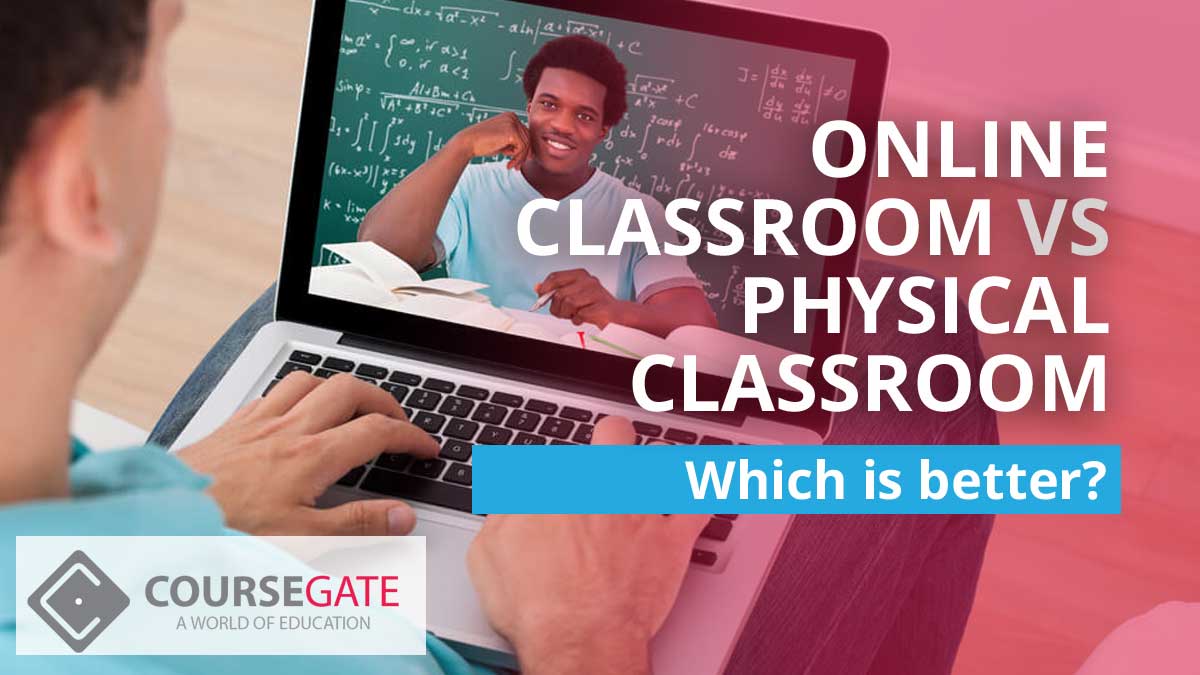
Classrooms have a direct effect on our learning and understanding process. Back in the day, classrooms meant only physical classrooms. But, online classrooms have gained immense popularity, especially after the emergence of the COVID-19 pandemic. This article will help you understand the difference between online classroom vs. physical classroom. After which, you will be able to distinguish between these two and choose the more suitable one for yourself or your child.
What is an Online Classroom?
An online classroom is a digital learning experience that allows teachers and students to connect online in real-time. Online classrooms use video conferencing, online whiteboards, and screen sharing to enable teachers to conduct live lectures, virtual office hours, and discussions with students in an interactive setting. Moreover, online classrooms are meant to replicate the experience of physical classrooms, with some added benefits of file sharing, instant feedback, and interaction, and are ideal in distance learning situations.

In addition, an online classroom showcases an online learning system that enables students and teachers to communicate and collaborate. Online classrooms are basically like cloud-based learning solutions and are run digitally. Therefore, they are highly customisable and accessible to all users on several devices. These include smartphones, tablets, laptops, etc.
What is a Physical Classroom?
Physical classrooms create a face-to-face environment for students and teachers. They refer to a classroom set-up where everyone can communicate with each other and engage. A physical classroom has different materials and furniture in them. This includes projection screens, board, teachers, class monitors, etc. Moreover, many of the elements in a physical classroom bring positivity and concentration to students regarding studies. They also help the students to feel less distracted. This is because an academic environment surrounds them.
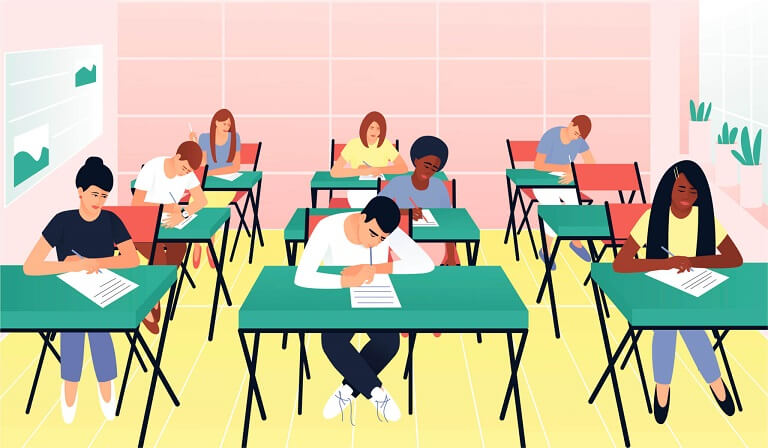
However, only books, lessons, and various class works don’t have to keep students engaged. Other things like furniture, classroom decorations, teacher’s behaviour, peers- play an essential role in indulging students into the classroom environment. It creates an ambience to make students feel inclined to study and focus more.
Online Classroom vs. Physical Classroom
Since we have now developed a good knowledge of what online classrooms and physical classrooms are, let’s see the critical differences between online classroom vs. physical classroom. First, let’s see the pros and cons of online classrooms.
Online Classroom- Pros & Cons
Online classrooms may be the perfect option for some, but not the correct choice for others. Therefore, it is best to know its pros and cons before deciding for a kid or an adult.

Pros of Online Classroom
There are several pros of online classrooms. However, some of the crucial pros of online classrooms include the following:
Provides a Safe & Comfortable Environment
Online classrooms allow you to study in the comfort of your own home. It is completely home-based, and you are in charge of your surrounding environment. There will be no classroom bullying, no fighting, etc. Also, there will be less disease transmission from others. Most importantly, from dangerous viruses such as COVID-19.
Complete Flexibility
Total flexibility is the primary advantage of online classrooms. Students can work on their assignments any time of the day, whenever they feel. Also, they can access all their classes from any location that has good internet service.

LIFETIME LEARNER PACKAGE

Say goodbye to one-off online courses and hello to endless learning possibilities! Get unlimited access to our entire course library forever
Cost-Effective
Online classrooms require fewer materials. So, it is cost-effective compared to the usual classrooms. Pupils only need to buy e-books and have a good internet connection to attend classes in an online classroom. They do not need to purchase expensive textbooks. Moreover, most of the materials are provided online by the teaching faculty. And, any additional costs, such as transportation, lab costs, are also not required to take online classes.
Cons of Online Classroom
Among the number of pros of online classrooms, there are some cons too. It depends on different people on what they want to focus more on. Therefore, let us now look at the cons now.
Less Socialisation
Physical classrooms have several options for students to engage and get involved in many recreational activities. On the other hand, there are fewer options for students in online classrooms. They can’t talk to others, interact in the classroom openly, etc. Students do all teamwork online, all by themselves. This makes them less social. Therefore, interpersonal skills such as teamwork, leadership, and social skills do not develop in them.
It also affects their mental growth and makes them socially not ready. On top of that, they miss out on classroom-related extracurricular activities such as class parties, face-to-face presentations, classroom games, etc.
Motivational Problems
Online classrooms expect the pupils to take authority over most of their work. But, sometimes it gets tricky for them to finish them on time. They have to work in isolation, with no peer or teacher to assist them physically if they get stuck somewhere. Thus, this is a significant disadvantage for students who are not very motivated and very bad at working in isolation instead of in groups.
Distractions
The list of distractions in an online classroom is vast. In a physical classroom, the environment is only suited for learning and getting to interact with others. But, in an online classroom, pupils are in their homes or any other comfortable place. This means that the primary purpose of that environment is not for learning. They are also not under the supervision of teachers.
For instance, at home, the amount of distractions is endless. There might be music playing in the next room, a serious family discussion in the other room, etc. Thus, the classroom environment is not distraction-free. It diverts the mind of pupils from their studies. This causes them to focus less.
Physical Classroom- Pros & Cons
The physical classroom environment is the most common and the most traditional learning environment. However, it has its own pros and cons list too. Let us have a look at some in this section.
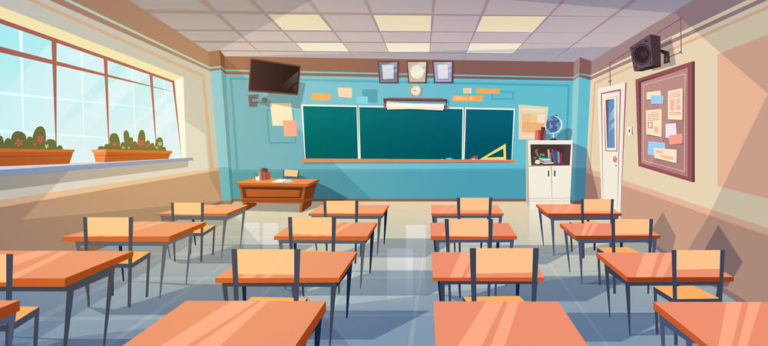
Pros of Physical Classroom
Physical classrooms have numerous advantages. Nothing else can beat learning with a proper physical classroom and face-to-face human interaction. Some of the pros are:
Respect towards one’s own physical and mental health and respect for your classmates/teammates is included in a physical classroom environment. Pupils can use this teaching in other social and working environments. It also encourages pupils to achieve through learning, gain recognition for their efforts and achievements, and raise their future aspirations to succeed. Pupils should be involved in learning in its widest sense, both inside and outside the classroom, to achieve their true potential.
In addition, physical classroom education teaches the students how to talk to others and show respect. They learn this through various classroom activities. For example- group projects, presentations, story sharing, etc.
Interactive Learning
Physical classrooms involve interacting with different teachers face to face, ask more questions if there is any confusion in a topic. Moreover, it allows students to interact with their peers. This builds up their team working and team-building skills. Students can brainstorm ideas amongst each other as well as get feedback from others.

The feedbacks can be both good or bad. The bad feedbacks can be treated as constrictive feedbacks, and they can work harder to achieve the desired results. Also, if one is struggling with any lesson or subject, face-to-face tutor help after school hours is available too. Thus, their self-confidence is boosted up through these special classes.
Discipline is a crucial part of learning. Most people prefer physical classrooms to ensure that students are learning how to behave, learn good manners alongside academic education. Waking up on time, getting ready for school, catching the public transport, acting correctly in class, etc.- these are all part of the disciple that the physical classroom teaches. In addition, discipline teaches students many lessons that can be converted into real-life scenarios when they grow up.
Self-discipline is one of the essential skills to have – significantly when revising for exams and working full time as an adult. Physical classroom education helps to teach this. Without discipline, all the other skills acquired by an individual go unnoticed. This skill helps to make the different skills and expertise shine brighter.
Moreover, the discipline also teaches individuals proper leadership skills and goal setting to prepare them for their future in work. If an individual is not disciplined, they can never be good leaders or goal setters. Thus, for example, allocating team captains for sports such as volleyball can help pupils learn to work with small groups and assist them in completing a common task (for example, score a goal).
Cons of Physical Classroom
Amongst all the pros of physical classrooms, there are some cons too. Thus, the most crucial cons are highlighted in this section. Let us have a look at some now.
Physical classrooms have a reasonable cost. Educational institutions charge more money from students if they are to learn in physical classrooms. However, in these challenging economic times, when many schools are getting the axe, and some districts are even laying off teachers, the expense of holding physical classrooms may cause some schools to reconsider whether the class is worth it. The cost and maintenance of classes and equipment, the expense of a gym, maybe money that’s better spent on retaining talented teachers or entire academic programs.

In addition, many schools and administrators base budget choices on the most important programs to students and parents: usually, those academic subjects measured on standardised testing. If the expense increases for a school, it would also directly impact the money it charges from students and their families. Thus, this creates division amongst students too. It builds up a notion that if you are financially more capable, you can afford the best form of education.
With physical classroom learning, students must physically attend the courses to get credit for attendance. Therefore, those who must travel long distances to get to school must allow enough time to arrive on time, particularly when inclement weather is involved.
Especially during the time of this global COVID-19 pandemic, it is also unsafe to travel. Thus, the risk of exposure to harmful viruses is high too. In addition, it would make the students more vulnerable to fall severely ill. Additionally, for students who are physically disabled, coming to school every day can create problems. They would have to always rely on someone else to take them to school. However, if they cannot commute to school sometimes because there is no other to take them, it would make them feel different from others and, therefore, are treated differently.
Less Flexibility
Physical classroom learning means the class schedule is already fixed and is not subject to change. Thus, they will not be able to take up specific jobs too. Some pupils face financial issues at home, and therefore they have to work to support their family and themselves, but a physical classroom education acts as a roadblock. Thus, less flexibility is one of the critical points in the Online classroom vs. Physical Classroom.
Closing Note
Education is essential for all. However, different people have different preferences when it comes to selecting the most suitable mode of education. Online classroom vs. Physical Classroom is an ongoing debate for several people. Sometimes, it gets challenging to pick the appropriate form of the classroom for yourself or a child. This article will help you solve all your dilemmas and educate you regarding online and physical classrooms.
Here at Coursegate, we have a wide range of courses to select from. Furthermore, all our courses are delivered online with 24/7 support from the team. Therefore, if you feel that online classrooms would be more suitable for you at the end of the debate of online classroom vs physical classroom, look into our well-equipped online courses!

All You Need To Know About Web Application Development

What is the Average IQ Score in the UK?
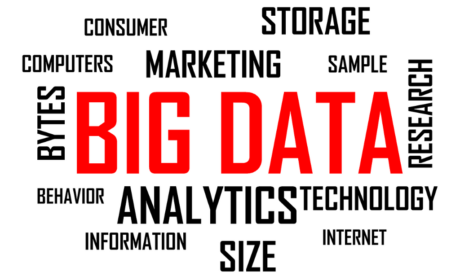
How to Become a Data Scientist in the UK

How Much Do Medical Billing and Coding Make [Everything You Need to Know]

How Much Does a Teaching Assistant Earn Per Hour in The UK [Everything You Must Know]

4 Challenges Medical Students Face and How to Encounter Them
- online classroom
- physical classroom
- All Courses
- ACCOUNTING & FINANCE 56
- ADMIN, SECRETARIAL & PA 45
- BUSINESS SKILLS 154
- Digital Marketing 48
- DIY (DO IT YOURSELF) 44
- Employability 207
- Food Hygiene & Safety 15
- HEALTH & FITNESS 65
- Health & Safety 97
- HEALTH & SOCIAL CARE 174
- Human Resource 47
- IT & SOFTWARE SKILLS 102
- Language 28
- LIFESTYLE 67
- MAKEUP & BEAUTY 42
- Management 129
- Marketing 60
- MASSAGE & PHYSIOTHERAPY 24
- Microsoft Office 64
- Nonprofit & Charity 55
- On Demand Courses 42
- Personal Development 133
- Photography 37
- Psychology & Counselling 87
- Quality Licence Scheme Endorsed 108
- SEN (SPECIAL EDUCATIONAL NEEDS) 23
- Teaching and Education 84

© Course Gate Edukite Ltd, Reg no: 11378092
Privacy Overview
Upgrade to get unlimited access to all courses for only £49.00per year.
No more than 50 active courses at any one time. Membership renews after 12 months. Cancel anytime from your account. Certain courses are not included. Can't be used in conjunction with any other offer.
- Military & Veterans
- Transfer Students
- Education Partnerships
- COVID-19 Info
- 844-PURDUE-G
- Student Login
- Request Info
- Bachelor of Science
- Master of Science
- Associate of Applied Science
- Graduate Certificate
- Master of Business Administration
- ExcelTrack Master of Business Administration
- ExcelTrack Bachelor of Science
- Postbaccalaureate Certificate
- Certificate
- Associate of Applied Science (For Military Students)
- Programs and Courses
- Master of Public Administration
- Doctor of Education
- Postgraduate Certificate
- Bachelor of Science in Psychology
- Master of Health Care Administration
- Master of Health Informatics
- Doctor of Health Science
- Associate of Applied of Science (For Military Students)
- Associate of Science (For Military Students)
- Master of Public Health
- Executive Juris Doctor
- Juris Doctor
- Dual Master's Degrees
- ExcelTrack Master of Science
- Master of Science (DNP Path)
- Bachelor of Science (RN-to-BSN)
- ExcelTrack Bachelor of Science (RN-to-BSN)
- Associate of Science
- Doctor of Nursing Practice
- Master of Professional Studies
The average Purdue Global military student is awarded 54% of the credits needed for an associate's and 45% of the credits needed for a bachelor's.
- General Education Mobile (GEM) Program
- AAS in Health Science
- AS in Health Science
- BS in Organizational Management
- BS in Professional Studies
- AAS in Criminal Justice
- AAS in Small Group Management
- AAS Small Group Management
- Master's Degrees
- Bachelor's Degrees
- Associate's Degrees
- Certificate Programs
- Noncredit Courses
- Tuition and Financial Aid Overview
- Financial Aid Process
- Financial Aid Awards
- Financial Aid Resources
- Financial Aid Frequently Asked Questions
- Financial Aid Information Guide
- Tuition and Savings
- Aviation Degree Tuition and Fees
- Professional Studies Tuition and Fees
- Single Courses and Micro-Credentials
- Time and Tuition Calculator
- Net Price Calculator
- Military Benefits and Tuition Assistance
- Military Educational Resources
- Military Tuition Reductions
- Military Spouses
- Student Loans
- Student Grants
- Outside Scholarships
- Loan Management
- Financial Literacy Tools
- Academic Calendar
- General Requirements
- Technology Requirements
- Work and Life Experience Credit
- DREAMers Education Initiative
- Student Identity
- Student Experience
- Online Experience
- Student Life
- Alumni Engagement
- International Students
- Academic Support
- All Purdue Online Degrees
- Career Services
- COVID-19 FAQs
- Student Accessibility Services
- Student Resources
- Transcript Request
- About Purdue Global
- Accreditation
- Approach to Learning
- Career Opportunities
- Diversity Initiatives
- Purdue Global Commitment
- Cybersecurity Center
- Chancellor's Corner
- Purdue Global Moves
- Leadership and Board
- Facts and Statistics
- Researcher Request Intake Form
Most Commonly Searched:
- All Degree Programs
- Communication
- Criminal Justice
- Fire Science
- Health Sciences
- Human Services
- Information Technology
- Legal Studies
- Professional Studies
- Psychology and ABA
- Public Policy
- Military and Veterans
- Tuition and Fee Finder
- Financial Aid FAQs
- Military Benefits and Aid
- Admissions Overview
- Student Experience Overview
- Academic Support Overview
Classroom vs. Online Education: Which One Is Better for You?

Both online learning and on-campus learning have pros and cons. The real question you might ask is: Which is better for me?
There are many factors to consider when determining which style of learning will fit you. Online learning has grown significantly since the COVID-19 pandemic, leading more students to embrace it.
Find out more about online vs. classroom education, what factors to consider, and how to choose.
What to Consider When Weighing Online vs. Classroom Learning
There are a number of factors to consider when deciding whether to attend an on-campus or an online program. Among the things to examine are:
Your Work Status
If you are balancing a full-time job and going to school, you may need a degree program that suits your busy schedule. On the other hand, a flexible schedule may be less important for full-time students. Which statement is most true for you?
☑ I work full time and need a flexible program that fits with my schedule.
Online education may be right for you.
☑ I work part time and have a more flexible schedule.
Either online or on-campus will work well for you. For students who have deep ties to where they live—due to work, family, or other reasons—distance learning provides access to programs virtually all over the world.
Where You Live
Which statement is most true for you?
☑ Moving isn’t an option.
Online may be a better option, especially if your local university doesn’t offer a program that interests you.
☑ I can live anywhere.
Either online or on-campus will work well for you.
Your Family Situation
Add family into the mix of balancing work, life, and school, and you need a program that allows you to study on your schedule:
☑ I have a family, so I need to take classes when my house is quiet.
Online education may be better for you.
☑ Family obligations aren’t a big issue for me.
Your Learning Style
Online learning provides many channels through which students and instructors interact with each other, including email, online chat, and video conferences. On-campus education provides communication through the same channels with the addition of in-person, in-classroom opportunities. Which statement is most true for you?
☑ I am comfortable communicating through email, chat, and video conferencing.
☑ I prefer in-person communication.
On-campus will probably suit you better.
There are many more factors to consider as you explore your options. Most importantly, you’ll want to find a college that offers a variety of programs so that you can find a degree that lines up with your career goals. For example, Purdue Global offers more than 175 online programs.
Although the COVID-19 pandemic accelerated the drive toward virtual learning, the trend has been building. That trend doesn’t mean that one option is better than the other; rather, technology has made it possible for universities to reach a wider audience. And the wider audience is responding to increased opportunities.
>> Read “ 3 Benefits of Online Learning ”
Quality of Online Learning vs. In-Class Learning
Before the pandemic, postgraduate online students tended to be older and studying part-time; they had to balance jobs and family, and they were ready for the rigors of distance learning.
Studies of post-pandemic learning are just now being done. One study indicates that online instruction appears effective in large introductory classes since students can use chats and virtual feedback to raise questions and connect in a more intimate format than giant lecture halls.
Another study indicates that online learning confers degrees more quickly than traditional classroom learning.
>> Read “ The Online College Student's Guide to Success: Tips, Tools, and Resources ”
Online Programs Can Provide Greater Convenience
The convenience and flexibility of online learning allows you to study any time, virtually anywhere you have an internet connection. It's an ideal solution for people with demanding work schedules and family obligations. In many situations, you can pause the content or go back to a portion to refresh your memory. This is incredibly helpful when you need to spend extra time on a challenging topic.
>> Read “ Time Management Tips for Busy College Students ”
Only you can decide whether online education or an on-campus college is best for you.
Visit our FAQ page for answers to common questions about the online learning experience, or request more information .
See Notes and Conditions below for important information.
About the Author
Purdue Global
Earn a degree you're proud of and employers respect at Purdue Global, Purdue's online university for working adults. Accredited and online, Purdue Global gives you the flexibility and support you need to come back and move your career forward. Choose from 175+ programs, all backed by the power of Purdue.
- General Education
- Legal Studies & Public Policy
- Online Learning
Your Path to Success Begins Here
Learn more about online programs at Purdue Global and download our program guide.
Connect with an Advisor to explore program requirements, curriculum, credit for prior learning process, and financial aid options.
Employment and Career Advancement: Purdue Global does not guarantee employment placement or career advancement. Actual outcomes vary by geographic area, previous work experience and opportunities for employment.

30,000+ students realised their study abroad dream with us. Take the first step today
Here’s your new year gift, one app for all your, study abroad needs, start your journey, track your progress, grow with the community and so much more.

Verification Code
An OTP has been sent to your registered mobile no. Please verify

Thanks for your comment !
Our team will review it before it's shown to our readers.

- Education /
Online Classes vs Offline Classes
- Updated on
- Jan 15, 2024
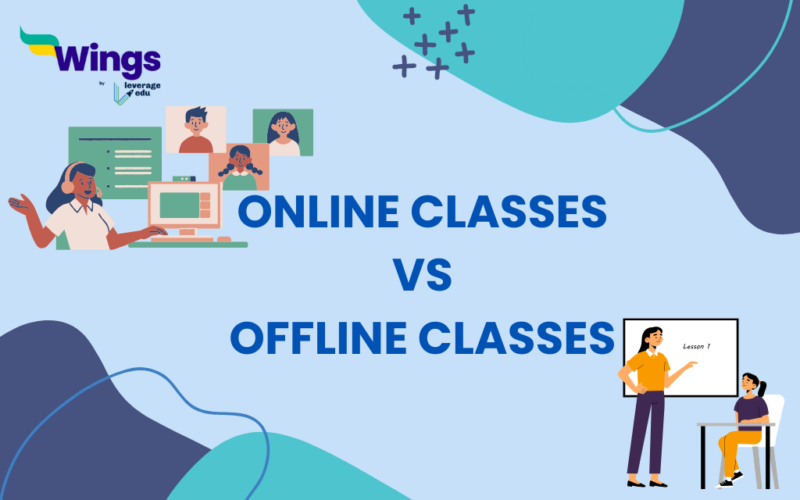
The Covid-19 pandemic brought a dynamic shift in the world education system . The imposition of lockdown led to the shutdown of physical classrooms and thus online education became the new norm. Although online learning has managed to keep education alive in these difficult times, it cannot completely replace it. Both online and offline education have their own set of advantages and disadvantages. In this blog, we will explore one of the most debated topics these days, online classes vs offline classes.
This Blog Includes:
Online education, offline education, mode of education in offline and online classes, accessibility, time management, flexibility of classes, student-teacher interaction, technical issues in offline and online classes, practical learning, pros and cons of an online degree.
With the emergence of technology , the method of delivering education has forever changed. As a matter of fact, online education has become a flexible instructional method of teaching wherein students can easily gain access to study material in the comfort of their homes. Moreover, online education provides an excellent opportunity for students who are unable to enrol in traditional classrooms as well as supports students in setting their own pace for studying.

Furthermore, online education helps in inculcating the habit of self-discipline and time management within students and provides them access to an unlimited number of educational resources. The students can easily set their own pace of learning as long as they have the right equipment and access to a proper internet connection.
Also Read: Online Education in India
Offline education is the traditional counterpart to online education and the original method of learning that allows students to have regular face-to-face interactions with their peers and teachers. However, as much as online education is predicted to be the future of learning, it cannot replace the holistic aspect of offline education.

Moreover, offline education also allows teachers to monitor the responses and behaviour of their students and accordingly address them as and when required. Hence, no matter how advanced online education is, offline education will continue to play a vital role in the development of students.
Also Read: Are Online Classes Becoming the New Normal?
Online Education vs Offline Education
While online education is not a new phenomenon, its importance came to light during the pandemic. Given below is a table that highlights the main differences between online education vs offline education.
When it comes to online classes, teachers can easily educate their students via virtual classrooms. Students can easily access learning materials from anywhere as long as they have proper access to an internet connection. Additionally, Online classes provide teachers with a number of online learning tools including videos, audio, animations, virtual whiteboards, virtual conference rooms and live chats with the students.
On the other hand, offline classes provide students with a practical learning environment within the walls of a physical classroom. It allows students to closely interact with their teachers as well as participate actively in live discussions and debates. Moreover, students can also participate in recreational activities like art and physical education which contributes to the overall mental and physical development of the student.
Also Read: Massive Open Online Courses
One of the greatest advantages of online classes is their accessibility from anywhere around the world. Students can simply log in from anywhere and gain access to learning material from the convenience of their homes. Applications like Zoom and Microsoft Team have allowed students to easily attend their lectures without having to leave the safety of their homes. Thus, online classes provide the distinct advantage of location flexibility.
However, offline classes require students to travel to the location of their educational institution. Teaching takes place in a fixed location which would typically comprise a lecture hall or a physical classroom. Additionally, certain students may need to travel far to reach their respective educational institutions and this may cause a great deal of inconvenience.
Students who attend online classes are faced with the big challenge of time management . Online learners are typically distracted by a multitude of tasks and they lack a proper schedule. Since online classes provide the advantage of self-paced learning, students may not have a proper schedule and may succumb to the habit of procrastination . Moreover, students are required to stay logged in to their online classes for an extended period of time which may lead to students surfing the web for distractions or checking their social media pages.
In the case of offline classes, students have to adhere to a strict schedule that has been set up by the teachers. Furthermore, since there is synchronous learning, students will be required to complete their work and projects on time.
The flexibility of classes is the main highlight of online classes. It allows students to set their own learning pace without any additional pressure. Additionally, since students have access to recorded videos and online reading material, they can easily attend lectures as and when it is convenient. It also gives students more time to digest the study material and complete their work or research at their own pace.
On the other hand, there is a certain amount of rigidity when it comes to offline education. Students are required to attend their lectures or sessions on time since there are no pre-recorded videos or notes that are easily available to the students. Hence, students are required to follow a predetermined and strict schedule as set by their educational institute.
Also Read: Pros and Cons of Online Learning Speech
Contrary to the popular belief that there is hardly any interaction between students and teachers in online education, there is an ample amount of interaction between students and teachers over the online platform. Online classes allow students to get in touch with their teachers no matter the time or location. Online classrooms also allow two-way communication which significantly influences learning. Moreover, student-teacher interaction in online classes may be both synchronous and asynchronous.
There is face-to-face interaction in the case of offline classes, especially because teaching is synchronous. There is active communication between students and teachers which allows for lively discussions and debates between them. Moreover, it allows students to immediately address their doubts and receive quick feedback. Teachers are adapting to different methods of teaching to engage students.
Online classes are always challenged by technical issues. Access to proper electronic equipment such as webcams, microphones, headphones and computers along with a proper internet connection is a mandatory requirement for online classes. Additionally, technical issues such as slow internet connection or lack of availability of proper technical infrastructure may interfere with seamless learning. Moreover, students may face difficulty in attending live lectures or downloading videos or online notes.
On the other hand, Offline classes, are rarely threatened by technical issues. Students and teachers are not required to be exceptionally tech-savvy and since most learning occurs within the physical classroom, technical issues are not a major issue except for any lessons that require presentations or computers.
Online education is purely theoretical and takes place entirely online. This scarcely allows students to take part in the practical aspects of learning which is an equally important part of education. Subjects like chemistry , physics , biology , art and sports require students to be physically present and conduct live experiments or actively participate in the activity.
Offline classes provide a stimulating environment that combines both theoretical and practical aspects of learning, unlike online classes. This contributes to the overall cognitive and skill development of the students. Practical learning allows you to learn and quickly adapt to daily challenges and scenarios and allows you to get a better understanding of lessons.
Watch this video to understand the Pros and Cons of an Online Degree right here!
Related Articles
Offline classes, as opposed to online classes, provide a stimulating environment that incorporates both academic and practical components of learning. This helps students’ overall cognitive and skill development.
Offline learning is preferable since it allows you to engage with other students in a more natural setting. You can ask questions, solve tasks, and receive personalised feedback from your teacher. Another benefit of offline classes is that they are more dependable.
The distinction between online and offline communication is traditionally viewed as a distinction between computer-mediated communication and face-to-face communication (e.g., face time). Offline is reality, while online is virtuality or cyberspace (i.e., real life or “meatspace”).
Online Classes vs Offline Classes which one do you prefer? For more information on such informative topics, visit our school education page and follow Leverage Edu .
Team Leverage Edu
Leave a Reply Cancel reply
Save my name, email, and website in this browser for the next time I comment.
Contact no. *
12 comments
Online classes is better than offline class in this covid19 pandemic situation
Hello Nasrin, We totally agree with you and believe that online classes do have their own share of advantages too. Here are some recommended reads that you can check out on the same: https://leverageedu.com/blog/online-learning/ https://leverageedu.com/blog/online-courses/ https://leverageedu.com/blog/online-classes-are-the-new-normal/
Very nice content
Acc. 2 me offline is better. As it boost 😤 Student confidence nd to talk freely with his /her teacher. As in online one can ask ques privately, perfectly clear doubt but isn’t it lower confudence . As he /she can ask his/her ques. But in future while in any situation when he /she need to do some open conversation or any other situation. He /she can’t able to do it perfectly. To b good there strt it frm starting.
Me offline class is best 🙂 Thank you
Hey Deepanshi, offline and online courses both have their merits and demerits. Glad to know that you find offline better!
In my opinion offline classes is best way of learning ☺️
Thank you for the comment!
The information you’ve shared in this blog is highly remarkable. Thanks for sharing quality information.
Thank you for such encouraging feedback. We are continuously working hard to bring all the important information for our readers regarding study abroad queries. If you are interested in knowing more about such study abroad related services call Leverage Edu anytime at 1800 572 000 for a free consultancy session.
Online classes make Health issues, spending so much time in front of computer cause bad affects on health But in Physical Offline Classes are very much better than online classes in my opinion, when you meet peoples physically your mind get open and with physically connect with teacher gets your study perfect. OFFLINE CLASSES ARE THE BEST in terms of everything
Well , i have a question though . what about introvert students ? Who are too shy to approach to the teacher , they are much more comfortable in online , aren’t they ?
Online classes are undoubtedly great for introvert students. But if you’re an introvert and you take offline classes, you will be able to build courage and confidence which will prove beneficial in the future.

Leaving already?
8 Universities with higher ROI than IITs and IIMs
Grab this one-time opportunity to download this ebook
Connect With Us
30,000+ students realised their study abroad dream with us. take the first step today..

Resend OTP in

Need help with?
Study abroad.
UK, Canada, US & More
IELTS, GRE, GMAT & More
Scholarship, Loans & Forex
Country Preference
New Zealand
Which English test are you planning to take?
Which academic test are you planning to take.
Not Sure yet
When are you planning to take the exam?
Already booked my exam slot
Within 2 Months
Want to learn about the test
Which Degree do you wish to pursue?
When do you want to start studying abroad.
September 2024
January 2025
Most Popular
11 days ago
How To Write a Synthesis Essay
13 days ago
OpenAI Has Launched A New Voice Assistant, And Here’s What You Need to Know
12 days ago
How To Write An Opinion Essay
From karl marx to toga shortages: reddit’s funniest essay mistakes, how to write a news article, online education persuasive essay sample, example.

It seems everything is moving online these days. Even our education is transferring onto the internet. Many people might squabble about the disadvantages of this phenomena, but today, I want to discuss the advantages of getting an education online. This is a pertinent topic, as the future of education is moving more and more towards shifting physical educational institutions online. There are reasons for this: many times you can learn whatever you want, it is more comfortable in a variety of ways, online courses often look good on resumes, the pacing of learning is managed by the learner, and the cost of virtual education is often lower than traditional education.

Flexibility and Accessibility of Online Education
The freedom to choose your educational path is an enduring quality of online education. For more creative people, or people who want to focus on a single activity, this can be a dream come true. According to elearning Industry, “You can pick the program of your dreams in traditional education, too, but that would involve traveling away from home, living in a completely unknown city, and struggling in an extremely competitive learning environment. With online education, you can take any program or course present in traditional four-year universities” (Norman, Stephanie). So, the ease of access to the courses and majors you are striving to study are widely available online. This increases opportunities to gain the education we desire instead of making needless compromises.
Comfort and Convenience: The Comfort Factor in Online Learning
Like the last point, comfort takes center stage for many students. Countless students choose online education in order to avoid wasting time travelling and on many other activities in order to attend physical education institutions. According to the Open Education Database, “Commercials that feature online students studying in their pajamas only skims the surface of one of the benefits of online education: no physical class sessions. Students listen to lectures and complete assignments sent to them electronically, with no need to fight traffic, leave work early for class, or miss important family time. Rather than miss important class sessions (due to weather conditions), students in online courses can always “attend” by participating in discussion boards or chat sessions, turning in their work on time, and watching lectures or reading materials” (“10 Advantages of Taking Online Classes”). In other words, by being an online student, you circumnavigate many of the issues that regular students endure on a daily basis.
Two Advantages of Online Education
In addition, many employers are happy to see online courses on resumes. Many recruiters see the taking of online courses as a sign of taking initiative. As stated by Pongo Resume, “Employers respect a degree earned online as much as a degree earned from attending a brick-and-mortar school. They understand that with the technological advances we have today, more and more employees are getting their education and training online. Because hiring managers value continuing education and professional development, having the relevant courses and programs in the education section of your resume will demonstrate that you are resourceful and have taken the initiative to stay ahead of the curve and improve professionally” (“The Advantages of Online Learning for You and Your Career”). Therefore, not only is online education seen as equal to regular education by employers, but it is also viewed as being competent in the latest technologies and trends.
Back to the students, one of the great advantages of online education is that learners can study at their own pace. According to eLearning Industry, “This type of system does not require attending live sessions; you can access the materials at any time that works for you. If you have to work or take care of your home and children during the day, you can study at night. That’s an advantage the traditional educational system cannot beat” (Norman, Stephanie). Besides, when studying online, people can also get some outside help without such a great pressure of deadlines. You can take all the time you need to browse through the best paper writing service review to find guidance and improve studies. In addition, people who want to take a longer time to receive a degree can do so without any pressure.
Cost Efficiency: An Attractive Aspect of Online Education
Finally, the cost of getting an online education is cheaper on average than receiving a traditional education. According to the Open Education Database, “Though not all online degrees offer less expensive net tuition prices than traditional colleges, associated expenses almost always cost less. For example, there are no commuting costs, and sometimes required course materials, such as textbooks, are available online at no cost. In addition, many colleges and universities accept credits earned via free massive open online courses (MOOCs), the most recent advance in online education” (“10 Advantages of Taking Online Classes”). Thus, there are a variety of reasons why an online education costs less.
Receiving an online education is becoming more and more popular due to a multitude of advantages it has over traditional instruction. These advantages include, to name a few: students can learn whatever they want, it is more comfortable, online courses often look great on resumes, the pacing of learning is managed by the pupil, and the cost is often lower than traditional education. With these reasons, it is hard to not see why this form of education is on the rise.
- Convenience is Key: One of the biggest perks of taking classes online is the convenience it offers. Whether you’re a busy professional or a student with a hectic schedule, you can fit your coursework into your routine.
- Increased Interaction: Contrary to popular belief, online learning can provide more opportunities for interaction with your classmates and instructors. With tools like discussion forums, video conferencing, and collaborative projects, you can build connections and engage in meaningful discussions.
- Expanded Learning Opportunities: Online classes can provide unique learning opportunities, such as self-paced coursework, access to multimedia resources, and the ability to connect with experts from around the world. These opportunities can enhance your educational experience and help you achieve your goals.
- Flexibility for Your Lifestyle: Online learning also provides flexibility that traditional classroom settings can’t match. You have the freedom to study when and where you want, allowing you to balance your personal and academic commitments.
- Affordable and Accessible: With online classes, you can save money on expenses such as commuting, textbooks, and housing. Additionally, you have access to a wider range of courses and programs that may not be available in your local area.
- Feelings of Isolation: One potential downside of online learning is that it may create a sense of isolation. Without the physical presence of classmates and instructors, it can be difficult to establish a sense of community and connection.
- Self-Discipline is a Must: Online learning also requires a significant amount of self-discipline. Without the structure and routine of a traditional classroom setting, it can be easy to become distracted or fall behind in your coursework.
- Instructor Training is Key: To ensure that online classes are effective and engaging, instructors must receive specialized training in online teaching methods. Without this training, it can be challenging to create a dynamic and interactive learning environment.
- Technical Difficulties: Online classes are also prone to technical issues, such as connectivity problems or software glitches. These issues can disrupt the learning process and cause frustration for both students and instructors.
- Increased Screen Time: Another potential drawback of online learning is the increased amount of screen time it requires. Spending too much time in front of a computer or other device can lead to eye strain, headaches, and other health issues.
Online education or e-learning has become a pivotal tool in shaping the future of education. With the advent of technology, distance learning has revolutionized the way knowledge is delivered, making it a compelling alternative to traditional educational systems. This influential composition aims to underline the undeniable advantages of virtual education.
One notable benefit of internet-based education is the extensive range of courses available at your fingertips. In contrast to traditional learning institutions where some specializations may not be offered, e-learning platforms provide an array of diverse courses. This means that learners, regardless of their field of interest, can find courses that suit their needs, enhancing their understanding and expertise in specific areas.
Additionally, online learning platforms often provide interactive sessions, webinars, and seminars , enabling students to communicate directly with their instructors. This access to experts in the field can drastically enrich the learning experience, making the information more relevant and easier to understand. This direct interaction, a feature often missing in traditional classroom settings, makes virtual learning a highly effective educational method.
Online learning has also proven to be a cost-effective option for many students. With resources like e-books and open-source software, internet-based education can significantly reduce the financial burden on students. Unlike traditional education, where textbooks and materials can be costly, digital resources are often much cheaper, and in many cases, freely accessible.
In addition to the benefits for students, online education provides opportunities for teachers to enhance their teaching methods. Through the use of digital tools, educators can create engaging lectures and activities, allowing them to convey complex ideas more effectively. Furthermore, e-learning platforms provide tools for tracking student progress, enabling teachers to provide personalized feedback and guidance.
To conclude, the benefits of online education are manifold. From the flexibility it offers to the wide variety of courses available, internet-based education is paving the way for a new era of learning . As we progress further into the digital age, it is likely that online learning will continue to grow and evolve, playing a significant role in shaping the future of education.
In order to effectively communicate the benefits of e-learning in a convincing essay , it’s important to provide concrete examples and demonstrations . Providing pointers on how to choose a program, manage time effectively, and utilize digital resources can add significant value to the piece and engage readers.
What are the main advantages of online education? Online education offers numerous benefits such as flexibility, a wide variety of course options, cost-effectiveness, and access to expert instruction and resources. It allows learners to manage their own pace of learning and reduces costs related to commuting and physical materials.
How can students maximize the benefits of online learning? Students can maximize the benefits of online learning by managing their time effectively, actively participating in online discussions and webinars, utilizing available digital resources, and maintaining open communication with their instructors.
Is an online degree as respected as a traditional degree? Yes, many employers respect online degrees as much as traditional ones. They understand that online learning requires self-discipline and initiative. In many fields, online learning is seen as being up-to-date with the latest technologies and trends.
* Note : To ensure the quality and originality of your writing, use an AI writer checker tool to review your persuasive essay before submission.
Works Cited
Norman, Stephanie. “5 Advantages Of Online Learning: Education Without Leaving Home.” eLearning Industry, 3 Aug. 2017, elearningindustry.com/5-advantages-of-online-learning-education-without-leaving-home.
“10 Advantages of Taking Online Classes.” OEDB.org, Copyright © 2006-2019 OEDb – Accredited Online, Specialty, and Campus-Based Colleges, 10 Aug. 2018, oedb.org/ilibrarian/10-advantages-to-taking-online-classes/.
“The Advantages of Online Learning for You and Your Career.” Pongo, www.pongoresume.com/articles/513/the-advantages-of-online-learning-for-you-and-your-career.cfm.
What are the main advantages of online education?
Online education offers numerous benefits such as flexibility, a wide variety of course options, cost-effectiveness, and access to expert instruction and resources. It allows learners to manage their own pace of learning and reduces costs related to commuting and physical materials.
How can students maximize the benefits of online learning?
Students can maximize the benefits of online learning by managing their time effectively, actively participating in online discussions and webinars, utilizing available digital resources, and maintaining open communication with their instructors.
Is an online degree as respected as a traditional degree?
Yes, many employers respect online degrees as much as traditional ones. They understand that online learning requires self-discipline and initiative. In many fields, online learning is seen as being up-to-date with the latest technologies and trends.
Follow us on Reddit for more insights and updates.
Comments (0)
Welcome to A*Help comments!
We’re all about debate and discussion at A*Help.
We value the diverse opinions of users, so you may find points of view that you don’t agree with. And that’s cool. However, there are certain things we’re not OK with: attempts to manipulate our data in any way, for example, or the posting of discriminative, offensive, hateful, or disparaging material.
Cancel reply
Your email address will not be published. Required fields are marked *
Save my name, email, and website in this browser for the next time I comment.
More from Best Persuasive Essay Examples

Jul 18 2023
Legal and Ethical Dilemmas within Higher Education Essay Sample Example

State Role in Education Essay Sample Example

Jun 14 2023
Early Assessment for Depression in Teenagers Essay Sample, Example
Remember Me
Is English your native language ? Yes No
What is your profession ? Student Teacher Writer Other
Forgotten Password?
Username or Email
- How It Works
- All Projects
- Top-rated Pages
- Admission essay writing
- Book report writing
- Coursework writing
- Dissertation writing
- Essay editing
- MBA essay writing
- Scholarship essay writing
- Term paper writing
- Write my essay
- Free sample essays
- Writing blog
Best Education Essay Examples
Online vs. traditional education.
1212 words | 5 page(s)
Today, when online education is becoming a vital part of the education family, almost all major American colleges and universities offer distance education, or online, courses. Online education, or as it is often called “e-education,” is able to reach a broader student audience, address the needs of learners in better ways, and save money, while using the principles of the contemporary learning pedagogy (Forman, 2001). Online courses allow students to take classes while living in different states or in different countries. Some schools offer traditional courses, online distance courses, or hybrid courses; the latter includes taking both traditional and online classes. Even schools with the most traditional educational strategies, often called “brick and mortar” schools, gradually start offering online courses in response to the skyrocketing number of students partaking in the online experience. As online education becomes increasingly popular among young people, pushing traditional educational models aside, it is necessary to compare and contrast these two approaches and find out which one offers more positive outcomes for students and their academic performance. The aim of this essay is to find out whether online learning is better, worse, or equal to traditional in-class learning while analyzing its advantages and drawbacks.
The difference between traditional and online education is especially noticeable in three dimensions: access to learning, classroom space, and the possibility of implementing innovative teaching practices. One of the major characteristics of online education is flexibility; the ability to take classes in any place with an internet connection at any time of the day or night. Traditional classes, on the contrary, are inflexible and much more teacher-centered (Barab, Thomas, & Merrill, 2001). Access to information is not limited to materials available in the classroom, and access to the classroom materials is no longer limited to the time of the lesson or to the physical classroom space. Being able to study when and where you like affords students from all walks of life with the availability of obtaining a degree. Whether the student is a young mother who is unable to attend traditional courses due to a lack of a babysitter, or a full time worker who cannot rearrange their schedule to make the traditional class times, these individuals will be able to obtain a degree regardless of that situation by simply taking online courses. The flexibility offered by the online education gives particular categories of students an important opportunity to meet their educational needs.
Use your promo and get a custom paper on "Online Vs. Traditional Education".
On the other hand, the advantage of traditional courses consists in offering student direct contact with teachers. Face to face communication allows students to ask questions concerning their classes and immediately get the answers they seek. Students are also able to meet with their classmates, developing friendships and fostering teamwork. The proponents of the traditional classroom model believe that the face-to-face contact allows students to enjoy the ability to learn with others and to know their instructors (McDonald, 2002). Indeed, learning in front of the PC may not be compared to the charm of going to lectures, living in the campus and visiting student parties, however, all of this has little to do with academic performance. The proponents of online learning argue that the latter offers students more time for digesting the information they receive and responding. They also claim that, while attending distance courses, students are able to better develop the skills needed in conducting open discussions, where each of the students receives more of an equal standing in comparison with a face-to-face discussion. This happens due to the fact that online students can make their responses around the clock with no restrictions, which enhances motivation and involvement on the learner’s part. Also, online classes provide an easy access to peers all over the world, which facilitates the establishment of a scholar networking for the intellectual exchange and collaboration purposes (McDonald, 2002). This has a profound impact on the professional life of the faculty, since it is no longer limited to geographical limits, when choosing collaborators.
The second significant difference between online and onsite education is classroom space. The very concept of the online learning has facilitated the invention of another, more suitable term – learning space. Online learning has been revolutionary in the world of education, creating an opportunity for collaboration, discussion and building a community among its participants, without being bound to the limits of a physical classroom. Usually faculty is free to choose between several online applications to encourage interaction through synchronous or asynchronous methods. Such methods work to extend class discussions, offering students the ability to delve deeper into a specific topic, affording students the opportunity to discuss a reading or build off of a lecture. This type of collaboration between students in the same class, students who may reside in different states or even in different countries the whole world over is possible only through the use of the virtual classroom (Barab, Thomas & Merrill, 2001).
The third significant difference between the two reviewed educational methodologies is the application of the new online teaching practices considered to be unusual for traditional education. Online learning strategies are known to involve innovational pedagogical technologies that greatly facilitate the process of learning. Such practices, as asynchronous and synchronous class discussions; constant commenting and answering questions of the classmates; application and document sharing were never or rarely used in the on-site courses before. In a traditional class, document sharing involved printing numerous copies of documents, thus involving additional costs. Collaboration and discussion in a group were limited by classroom space, restricted to a standard lesson time and to the opportunity of being heard and seen in the classroom (McDonald, 2002). Acquisition of these practices by the online education programs has turned them into an efficient and fascinating way of learning.
It is possible to see that there are different benefits to both the traditional education and the online education offered to students in this day and age. There are some individuals who are unable to work without direct classroom instruction; they are auditory learners, not visual ones, and for them the traditional classroom will be the place in which they are able to shine. Other students are visual learners, finding the traditional classroom tedious and boring, with the auditory lectures a waste of time as they have already read all of the material covered in the lecture. These visual learners excel when placed in an online classroom, as they are able to work at their own pace as opposed to the pace of the teacher or professor. While it cannot be stated that one method is better or worse than the other, it can be stated that one method will be better for some students than it will be for others, allowing college students to get the most out of their college experience and providing them with the availability to do it their own way.
Have you enjoyed reading this sample? Make sure to check more college essay examples from our best writers online!
- Barab, S., Thomas, M. & Merrill, H. (2001). Online Learning: From Information Dissemination to Fostering Collaboration, Journal of Interactive Learning Research 12(1), 105-143.
- Forman, R. O. (2011). A comparison of success in on-campus versus distance learning for information systems course. Issues in Information Systems, 12(2), 63-66.
- McDonald, J. (2002). Is “as good as face-to-face” as good as it gets? Journal of Asynchronous Learning Networks, 6(2), 10-23.
Have a team of vetted experts take you to the top, with professionally written papers in every area of study.
Home — Essay Samples — Education — Physical Education — Importance Of Physical Education
Importance of Physical Education
- Categories: Academic Performance Physical Education
About this sample

Words: 521 |
Published: Mar 19, 2024
Words: 521 | Page: 1 | 3 min read

Cite this Essay
Let us write you an essay from scratch
- 450+ experts on 30 subjects ready to help
- Custom essay delivered in as few as 3 hours
Get high-quality help

Prof Ernest (PhD)
Verified writer
- Expert in: Education

+ 120 experts online
By clicking “Check Writers’ Offers”, you agree to our terms of service and privacy policy . We’ll occasionally send you promo and account related email
No need to pay just yet!
Related Essays
7 pages / 3003 words
4 pages / 1770 words
2 pages / 686 words
7 pages / 3056 words
Remember! This is just a sample.
You can get your custom paper by one of our expert writers.
121 writers online
Still can’t find what you need?
Browse our vast selection of original essay samples, each expertly formatted and styled
Related Essays on Physical Education
Why is physical education important? This essay discusses the benefits of physical education and its importance for children in schools. First of all, P.E helps kids who do not have an active lifestyle at home be healthy [...]
Should PE Affect a Student’s Grades? This question has sparked debates in educational circles for years. The inclusion of physical education (PE) in a student's curriculum is not just about promoting physical activity but also [...]
As a highly competitive sport, running involves various ethical, environmental, and educational considerations. This essay explores these aspects, starting with the ethical dilemmas surrounding performance-enhancing drug use in [...]
Physical education is an integral component of a well-rounded education, and its importance cannot be overstated. In this essay, we will explore the myriad benefits of physical education for students, focusing on its role in [...]
Over the past several years, there have been numerous reports documenting the decline of participation in physical activity among youth. There are various factors that can be in consideration of one or many reasons on why the [...]
Physical education has turned out to be an integral part of the lives of those who guarantee better health and ensure a happy life. As far as the meaning of physical education is concerned, it can be defined as a process that [...]
Related Topics
By clicking “Send”, you agree to our Terms of service and Privacy statement . We will occasionally send you account related emails.
Where do you want us to send this sample?
By clicking “Continue”, you agree to our terms of service and privacy policy.
Be careful. This essay is not unique
This essay was donated by a student and is likely to have been used and submitted before
Download this Sample
Free samples may contain mistakes and not unique parts
Sorry, we could not paraphrase this essay. Our professional writers can rewrite it and get you a unique paper.
Please check your inbox.
We can write you a custom essay that will follow your exact instructions and meet the deadlines. Let's fix your grades together!
Get Your Personalized Essay in 3 Hours or Less!
We use cookies to personalyze your web-site experience. By continuing we’ll assume you board with our cookie policy .
- Instructions Followed To The Letter
- Deadlines Met At Every Stage
- Unique And Plagiarism Free
share this!
May 27, 2024
This article has been reviewed according to Science X's editorial process and policies . Editors have highlighted the following attributes while ensuring the content's credibility:
fact-checked
trusted source
Virtual training may be an effective, cost-efficient option for child educators
by Katie Bohn, Pennsylvania State University

Teachers and other child educators can benefit from regular professional development, but in-person training can be expensive. New research found that virtual training can be a budget-friendly alternative—and especially effective for certain groups of educators.
The study—a collaboration between researchers at Penn State and the University of Nebraska-Lincoln and published in the International Journal of Professional Development, Learners and Learning —found that educators who took a virtual training reported feeling more confident in their abilities to implement practices shown to support positive youth development.
In particular, after-school providers who did not have a four-year degree and were relatively new to teaching experienced the most growth in their feelings of self-efficacy.
Co-author Benjamin Bayly, assistant professor in family studies , child, and youth development in the College of Agricultural Sciences, said the work suggests that virtual professional development has the potential to be an effective way to reach a vast audience of educators who otherwise may not have the opportunity to participate in these trainings.
"Early care and education programs are often limited in financial resources and their workforce is often stretched thin, making it difficult to participate in professional development," Bayly said. "Virtual professional development represents an alternative that is low cost and can be completed on teachers' own time."
Education quality has a direct impact on children's development, the researchers said, and has been shown to predict future academic success and social and emotional well-being for children of all ages.
For teachers and other educators to provide high-quality educational experiences, the researchers said it's important they are trained in and feel confident implementing the most up-to-date pedagogical theories and best practices in their classrooms. This can be achieved through professional development, traditionally completed in person.
For example, an early care and education program may bring in an outside expert to conduct a workshop with the aim of improved instructional and emotional support in the classroom.
"However, given the high rate of turnover in early care and education programs , these teachers may leave and be replaced by new teachers who have not completed the workshop," Bayly said. "It may not be feasible for the program to continuously bring in an outside expert to train teachers every time new teachers come on board."
As an alternative, training can be done in an online setting. Penn State Extension, for example, offers virtual evidence-informed professional development to early care and education and youth-development professionals to improve the quality of their care and educational practices through its program, Better Kid Care.
"All of Better Kid Care's courses are on-demand, meaning professionals can take the course whenever they want," Bayly said. "The vast majority of the courses offered by Better Kid Care are designed to take two hours and are approved for professional development credits in 49 states."
But while virtual training can reach a larger audience and be more cost effective than in-person professional development, research on its effectiveness has remained mixed. Bayly said he and the rest of the research team wanted to better evaluate the impact of virtual training and whether certain groups may benefit more than others.
For the study, the researchers collected data from 3,535 educators accessing positive youth development courses through Better Kid Care. Educators varied in their specific roles, the ages of children they worked with, the level of their own education and how many years of experience they had.
After completing the virtual course, educators completed a post-test that asked them questions about what they had just learned, as well as how they would have responded to those same questions before taking the training. This was designed to assess changes in the participants' learning.
Participants also were asked to rank how confident they felt in their ability to apply learnings from the course, for example, "When working with children and youth, I can recognize their individual differences and make changes to activities to meet these differences."
Taken together, the researchers said the study's findings suggest that on-demand professional development is a promising way to increase educators' self-efficacy, but the courses may have different impacts depending on factors such as education level, role and experience.
Bayly said after-school providers without a four-year degree appear to have benefited the most from the virtual training because they were relatively new to the field and likely had not received a comparable amount of training compared to the other educators who completed the course.
"Also, because the courses were dedicated to supporting positive youth development , it is likely that the content resonated with them, which has been shown to impact participants' engagement and the effectiveness of the professional development opportunity," Bayly said.
The researchers said because there is great variability in the quality of virtual professional development—and as a result, great variability in the effectiveness of the trainings—additional studies should continue to evaluate the effectiveness of virtual professional development, both on its own and in comparison to in-person professional development and hybrid models.
Provided by Pennsylvania State University
Explore further
Feedback to editors

Florida fossil porcupine solves a prickly dilemma 10 million years in the making
46 minutes ago

GPT's inaccuracies in agriculture could lead to crop losses and food crises
51 minutes ago

Health risks from global warming can help drive city climate action, study finds
53 minutes ago

Bacterial model helps reveal how our bodies prevent population explosions—and cancer

Tropical forest resilience to seasonal drought linked to nutrient availability

Salty soil sensitizes plants to an unconventional mode of bacterial toxicity

Study introduces a cleaner way to produce ammonia at room temperature and pressure

A change of direction: Research reveals a new method to manipulate cell movement in embryos

New approach enhances accelerator's capability to uncover clues from supernovae in lunar dust

New molecule found to suppress bacterial antibiotic resistance evolution
Relevant physicsforums posts, is "college algebra" really just high school "algebra ii".
17 hours ago
UK School Physics Exam from 1967
Physics education is 60 years out of date.
May 16, 2024
Plagiarism & ChatGPT: Is Cheating with AI the New Normal?
May 13, 2024
Physics Instructor Minimum Education to Teach Community College
May 11, 2024
Studying "Useful" vs. "Useless" Stuff in School
Apr 30, 2024
More from STEM Educators and Teaching
Related Stories

AI can teach math teachers how to improve student skills
Dec 8, 2023

Rural educators find solutions to support multilingual learners
Mar 28, 2023

Study identifies best ways of helping teachers adopt supports for students with autism
Aug 16, 2023

No soft skills training spells missed opportunity for many organizations
Mar 14, 2024

Strong professional development networks benefit autistic students
Dec 6, 2021

Online science and math resources for teachers of young children
Jul 27, 2021
Recommended for you

First-generation medical students face unique challenges and need more targeted support, say researchers

Investigation reveals varied impact of preschool programs on long-term school success
May 2, 2024

Training of brain processes makes reading more efficient
Apr 18, 2024

Researchers find lower grades given to students with surnames that come later in alphabetical order
Apr 17, 2024

Earth, the sun and a bike wheel: Why your high-school textbook was wrong about the shape of Earth's orbit
Apr 8, 2024

Touchibo, a robot that fosters inclusion in education through touch
Apr 5, 2024
Let us know if there is a problem with our content
Use this form if you have come across a typo, inaccuracy or would like to send an edit request for the content on this page. For general inquiries, please use our contact form . For general feedback, use the public comments section below (please adhere to guidelines ).
Please select the most appropriate category to facilitate processing of your request
Thank you for taking time to provide your feedback to the editors.
Your feedback is important to us. However, we do not guarantee individual replies due to the high volume of messages.
E-mail the story
Your email address is used only to let the recipient know who sent the email. Neither your address nor the recipient's address will be used for any other purpose. The information you enter will appear in your e-mail message and is not retained by Phys.org in any form.
Newsletter sign up
Get weekly and/or daily updates delivered to your inbox. You can unsubscribe at any time and we'll never share your details to third parties.
More information Privacy policy
Donate and enjoy an ad-free experience
We keep our content available to everyone. Consider supporting Science X's mission by getting a premium account.
E-mail newsletter

IMAGES
VIDEO
COMMENTS
The article compares and contrasts online classes and traditional classes. Among the advantages of online classes are flexibility and convenience, while in-person classes offer a more structured learning environment. The author highlights that online lessons can be more cost-effective, although they lack support provided by live interactions.
Metrics. The coronavirus pandemic has forced students and educators across all levels of education to rapidly adapt to online learning. The impact of this — and the developments required to make ...
Contrary to the physical learning environment, participants can better maintain concentration online and achieve the desired benefit. One of the biggest advantages of digital learning is that new knowledge can be accessed when your course participants are ready. Another big advantage is that they can access learning where it best suits them.
With online courses colleges and universities haves made tremendous impact on the instruction and student learning. Distance education opportunities have brought the classroom from the university or college settings to the home, allowing students the privilege of pursuing college degrees without the inconvenience of actually traveling to campus to take the course.
Mar 4, 2024. --. In the ever-evolving landscape of education, the debate between physical education and online education continues to be a topic of discussion. Both methodologies offer unique ...
A meta-analysis of blended learning and technology use in higher education: From the general to the applied. Journal of Computing in Higher Education, 26(1), 87-122. Cavanaugh, J.K. & Jacquemin, S.J. (2015). A large sample comparison of grade based student learning outcomes in online vs. face-fo-face courses.
I t's been a full year since thousands of university faculty and millions of students made what's likely the largest adjustment in instructional delivery in history, migrating mid-semester from physical classrooms to online ones. As the possible end of this great transition nears, higher education is exhaling a collective sigh of relief—but there is a new question facing most university ...
In physical education teacher education (PETE), while there are strong and theoretically based proposals to educate PETE graduates to effectively use technology to enhance teaching and learning (Gawrisch et al., 2020; Krause et al., 2020), there is a lack of shared knowledge on the pedagogical and technological practices of contributing to online teaching and learning in PETE.
The Ongoing Debate: Physical Classroom Vs. Online Classroom. Around the world, the COVID-19 pandemic has emptied schools and pushed back the start of the academic year. Little kids are now forced to study online, attend online classrooms, and LEARN! With the distinctive need and rise of e-learning, whereby teaching is undertaken remotely and on ...
A common misperception of online education has been that it is an isolating experience for students. In fact, research studies that I have conducted with colleagues show quite the opposite ...
By examining the strategic goals of online learning, college facilitators, faculty, and instructors find that while online education thus targets learners, develops their skills, encourages student participation, and promotes scientific innovation, its full implementation remains underdeveloped (Andrade et al., 2020). Some universities have ...
Physical education as a discipline has long fought to be taken as seriously as its academic counterparts. Even before the pandemic, fewer than half the states set any minimum amount of time for students to participate in physical education, according to the Society of Health and Physical Educators (SHAPE), which represents PE and health ...
The COVID-19 pandemic forced the education sector to transform significantly in order to support students across the world. Technology played a crucial role in enhancing and adapting traditional learning to digital resources and networks, which are now an essential component of education. However, there is concern about the quality of teaching and its effectiveness in remote teaching due to ...
5. Cost-Effectiveness. Online schooling is significantly more cost-effective than physical schooling. As a parent, you should provide your children with the best quality of education possible. This also means investing more savings into higher education, i.e., undergraduate university, grad school, and so on.
Flexibility: Online education offers flexibility in terms of location, timing, and pace of learning, making it suitable for diverse learners (UNESCO, 2020). However, it requires a high level of ...
The study showed that, students assessed physical education learning with online learning is very effective (8.3%) effective (36.9%) normal (40.2%) although there are also students who think ...
Less Socialisation. Physical classrooms have several options for students to engage and get involved in many recreational activities. On the other hand, there are fewer options for students in online classrooms. They can't talk to others, interact in the classroom openly, etc. Students do all teamwork online, all by themselves.
There are many factors to consider when determining which style of learning will fit you. Online learning has grown significantly since the COVID-19 pandemic, leading more students to embrace it. Find out more about online vs. classroom education, what factors to consider, and how to choose. What to Consider When Weighing Online vs. Classroom ...
The Covid-19 pandemic brought a dynamic shift in the world education system.The imposition of lockdown led to the shutdown of physical classrooms and thus online education became the new norm. Although online learning has managed to keep education alive in these difficult times, it cannot completely replace it. Both online and offline education have their own set of advantages and disadvantages.
In the UK, for instance, the online education market is expected to grow by 9.69% by 2027. This trend took off in 2021 when around 89% of class content was being taught remotely by UK secondary schools. Let's delve into some of the compelling reasons why online learning is better than physical classrooms. Flexibility and Convenience.
Online education offers numerous benefits such as flexibility, a wide variety of course options, cost-effectiveness, and access to expert instruction and resources. It allows learners to manage their own pace of learning and reduces costs related to commuting and physical materials.
Attending a traditional school prepares students for life in a diverse society (Lawrence, July 5, 2013).". Online school is better because you can work at your own pace and students can focus and avoid distractions from other students. For example, students can access their course at any time, from anywhere they can log on, in most cases.
Online education, or as it is often called "e-education," is able to reach a broader student audience, address the needs of learners in better ways, and save money, while using the principles of the contemporary learning pedagogy (Forman, 2001). Online courses allow students to take classes while living in different states or in different ...
Physical education helps foster a sense of responsibility and teaches students how to set and achieve personal fitness goals. These skills are transferable and can benefit students in their personal and professional lives. Furthermore, physical education promotes social interaction and inclusivity. It provides opportunities for students to ...
Credit: Unsplash/CC0 Public Domain. Teachers and other child educators can benefit from regular professional development, but in-person training can be expensive. New research found that virtual ...